Skills-based success: 10 recruiting case studies

The working world has been turned on its head with the pandemic, the Great Reshuffle, and the resulting skills shortage. Companies are searching for a powerful, sustainable way to recruit and retain talent, and 81% of them are now opting for skills-based hiring practices.
Skills-based recruitment practices are for everyone. Don’t believe us? We've put together 10 recruiting case studies that demonstrate how different individuals, industries, and regions have successfully implemented skills-based hiring.

Table of contents
What's the purpose of a recruiting case study, 3 personal recruiting case studies, 3 recruiting case studies by industry, 4 recruiting case studies by region, looking for more recruiting case studies, the state of skills-based hiring 2024.
Read TestGorilla's annual report to discover why over 81% of companies are choosing to adopt skills-based hiring methods in 2024.

In recruitment, case studies are helpful tools for employers seeking to build, develop, or optimize their recruitment processes. They can be great sources of information and inspiration. By understanding the successes and failures others have had with their hiring processes, hiring managers can take any relevant learnings without having to make the same mistakes that others have.
To make these recruiting case studies relevant for as many people as possible, we've divided them into personal case studies, case studies by industry, and case studies by region. Let's dive in.
Let’s first look at the personal stories of some stellar individuals who were recruited into their ideal industries using skills-based practices. These people didn’t have traditional backgrounds, but because of their unique skills, they got into amazing roles. All that was needed was a chance to prove those skills during recruitment.
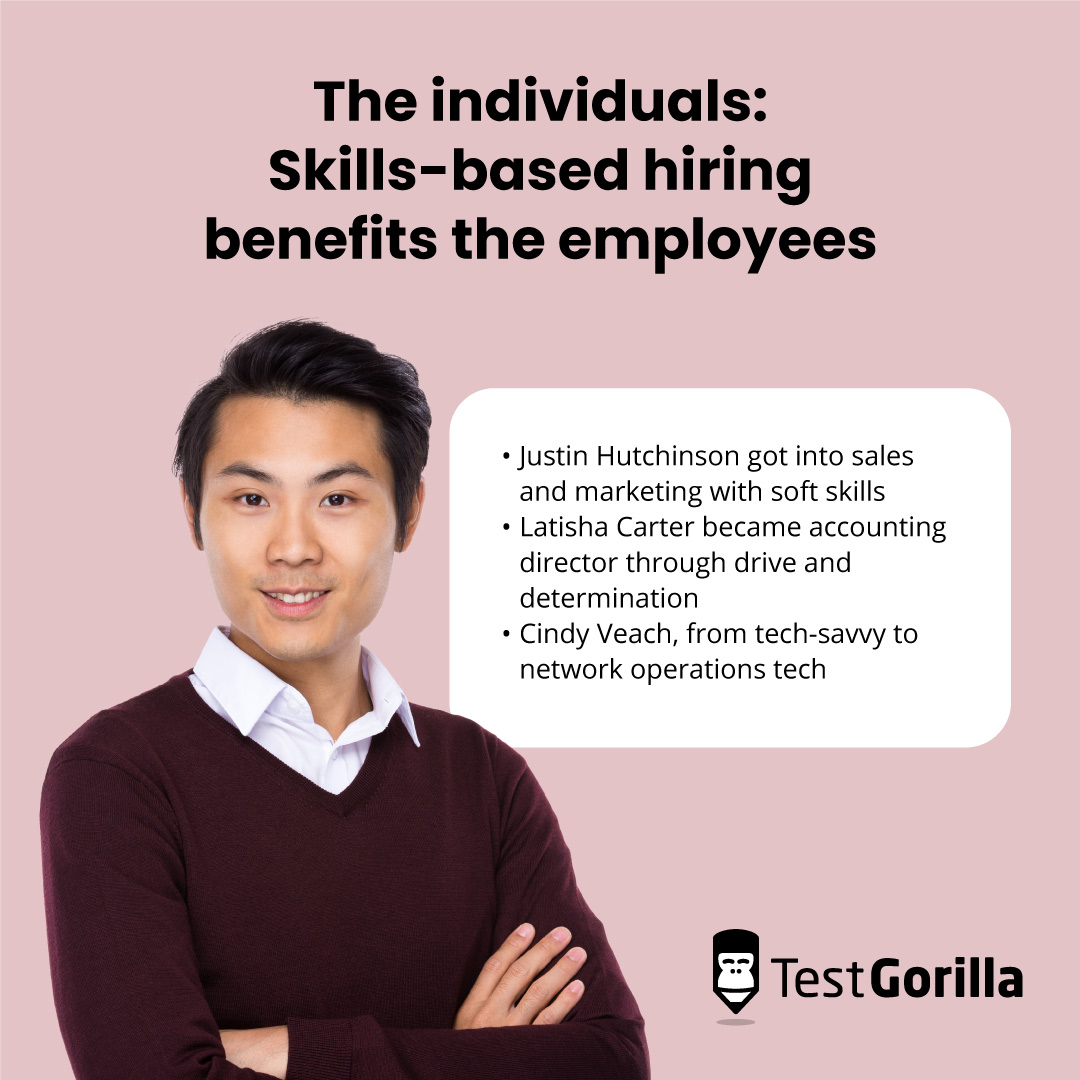
1. Justin Hutchinson
Justin Hutchinson wanted a future in football, but he was faced with a hard choice at age 14: Focus on his career prospects or take care of his father with cancer.
Justin, of course, chose his father and has never regretted that choice, but it did mean giving up the chance of achieving his dream job.
After his father’s passing, Justin attended a community college to fulfill his father’s wish for him to get a degree. To pay rent and living expenses, Justin got a job at a smoothie franchise.
His aim was to simply support his cost of living by making fast food – but it turns out Justin’s real skill was people and communication.
Justin would study the cars that drove up, memorize their orders, and have them ready so he could spend time talking and getting to know the customers instead of making drinks.
One of Justin’s customers was a chief executive of a marketing company and was so impressed with his people skills, he offered Justin an internship.
It wasn’t long before Justin used his soft skills to turn that internship into a full-time position. He dropped out of college, poured his heart and soul into the role, and attained the role of Director of Business Development.
Justin attributes his success to his best skills:
Workplace empathy
Strategic and critical thinking
Sales management
Justin didn’t have a typical marketing background – his experience was a partial college education with no degree, on-the-job experience (and not a traditionally “relevant” job), and his internship.
Not everyone can find the perfect marketer in a charismatic smoothie server, but online skills testing holds the same principles: Look at abilities first and ask questions later.
Sales and marketing are industries that are uniquely dependent on soft skills, which makes skills-based hiring an obvious choice for recruiting. For information on how it helps with the tricky subject of ramp time, read our article on skills-based hiring and ramp time.
2. Latisha Carter
Latisha Carter had a dream of excelling in corporate America, but she never got the opportunity to attend college.
At age 17, Latisha became a single mother. This put her dreams of college on hiatus for the foreseeable future.
Three years later, after having another child, Latisha got a job as a nursing assistant. But she still couldn’t shake her desire to make it in the corporate world.
She secured a call center job with NCR, a software company, driven by their offer of extensive employee training.
Offering extensive upskilling and reskilling is one of the best things you can put on the table for potential candidates. A study by Lorman showed that 59% of Millennials believe that development opportunities are extremely important when deciding whether to apply for a position.
Latisha used her experience at NCR to get a role in customer service at the software company Sage.
With determination and hard work, she continued to work her way up for 20 years until she became a director at Xero, an accounting technology company.
Latisha is now proudly a director in corporate America with no college degree. Her company is reaping the benefits of her presence and skills.
In the second half of 2021, Xero’s approach to skills-based hiring and its emphasis on diversity pushed a 7% increase in racial and ethnic diversity.
Jana Galbraith, the executive general manager for people experience partnering for Xero, says: “ [H]istorically, hiring based on degree exclusively has perpetuated discrimination .”
This boost is great news for Xero because the benefits of diversity are broad and include increased productivity, innovation, and financial performance.
Latisha’s struggle to succeed is unfortunately common for working mothers. To learn more about this, read our article on the motherhood penalty .
3. Cindy Veach
Cindy Veach didn’t have a traditional background. She had all the tech know-how, but she only had experience involving massage therapy and social services.
But she had the skills and she knew it. Cindy says it was a happenstance that she stumbled upon her perfect role; she just wanted a role where she could use her best talents.
“I was looking for jobs I had the right skills for, organizational skills in particular,” said Cindy.
She happened upon a tech administration apprenticeship program at IBM. Before then, she saw her tech skills as just a hobby and never imagined herself in the tech industry – but she applied and was accepted.
Cindy had a steep learning curve ahead of her. She possessed the base tech skills but needed the training to reach the right level.
She attributes much of her success to the flexibility of her mentors. They continually told her that if a path “didn’t feel right,” she was welcome to experiment and try something new.
At the end of the apprenticeship, she applied for a network operations technician role and was hired. She took a position with flexible work options so she could still care for her two children comfortably.
Skills-based hiring made this outcome possible. Cindy’s communication skills, digital expertise, and problem-solving abilities helped her secure her role, and the focus on continuous improvement is helping her develop it .
She says that the combination of her appetite for learning and her employer’s support for her success is the perfect duo for creating limitless growth.
We’ve heard plenty of people say “skills-based hiring doesn’t work in my industry.” But that’s just yet another myth we’ve debunked . Let’s take a look at a handful of case studies about how companies within certain industries have succeeded with skills-based recruitment initiatives.

4. Healthcare
Healthcare administration is an industry that’s notoriously difficult to get into. Between receiving a bachelor’s degree and completing a master’s program, it can take six to eight years of rigorous commitment.
However, more opportunities are arising that allow equally qualified candidates to get in without obtaining specific educational requirements.
Sam Saucedo-Hernandez had a tumultuous life, but she only ever wanted a solid career. As a child of parents who emigrated from Mexico, she wanted to be the first generation in her family to attain a degree.
Sam watched her parents struggle with low-wage jobs and promised herself she would do better for herself.
Her first attempt was at law school where she spent several years studying hard. Sam was ecstatic to get her degree and begin a career in law.
But two weeks after she got her associate of science degree, the school got shut down for fraud, leaving Sam jobless and $60,000 in debt.
Sam faced many challenges, but the turning point in her story was the day she received a letter promoting a no-cost medical administrative assistant job training program from JVS.
JVS is a program that helps people build skills and find solid career connections – particularly in the healthcare industry.[1]
JVS has seen amazing success with over 500 employer partners and an emphasis on promoting diversity: 88% of their participants are Black, Hispanic, Asian, or a wide range of other ethnicities.
Sam applied for the program and was accepted. She secured a position as a medical administrative assistant, but her training has led her to her current role in the audiology department.
Though she’s fortunate for her position, Sam says she’s still looking forward, wondering where her skills can take her from here.
Programs like JVS are working tirelessly to make more stories like this possible. With a focus on skills over experience, they bring in valuable candidates to industries that may otherwise be restricted to them.
5. Manufacturing
Steelcase, a furniture manufacturing company, wanted to build a fairer place for employment opportunities and encourage better representation for employees of color. So they adopted skills-based hiring practices.
They’re far from the only ones. According to TestGorilla’s State of Skills-Based Hiring report, 85% of businesses in 2023 had the goal to increase diversity.
And companies are succeeding at this by implementing skills-based hiring: 91% of organizations saw an increase in diversity due to skills-based hiring.
Steelcase realized that if they truly wanted to boost their DE&I initiatives , traditional hiring methods wouldn’t do.
They decided their hiring processes needed to be revamped for the better, so they adopted some new practices:
Prioritizing skills over resume and pedigree
Removing experience requirements wherever possible
Favoring continuous improvement over perfection
Revamping job descriptions to reduce biased language
Prioritizing diversity among equally qualified candidates
Steelcase decided that practices like these would enable them to reach diverse talent organically, and it worked. Since the program started, Steelcase’s new hires are 55% women and 30% racial or ethnic minorities.
Steelcase’s initiatives are amazing, so we encourage similar active moves to boost diversity. To read more about this topic, read our blog on why being intentional about workplace diversity is non-negotiable .
6. Software
ADP, an HR management software company, adopted a recruiting strategy to focus on skills , rely less on credentials, and make an effort to provide opportunities for candidates with nontraditional backgrounds.
This strategy included training talent acquisition professionals on best practices, hiring specific diversity recruiters, removing degree requirements from high-volume recruiting roles, and leveraging better training and mentorship for new hires.
What were the results? ADP saw great success in one year:
An increase in the number of candidates with no college degree
An increase in Black representation in the candidate pool
An increase in Hispanic representation in the candidate pool
This program was heavily inspired and backed by Maria Black, the chief executive of ADP, and her strong belief in corporate social responsibility.
She has a strong passion for supporting working women, veterans, and other underrepresented talents.[2]
Maria is an excellent example of the power of leading from the top. When your company’s leadership supports a great cause, it benefits both employees and company alike and builds a better organizational culture .
Next, let’s take a look at some case studies about the regions and countries that are taking on skills-based recruitment practices. For more on this subject, check out our post on skills-based hiring around the world .
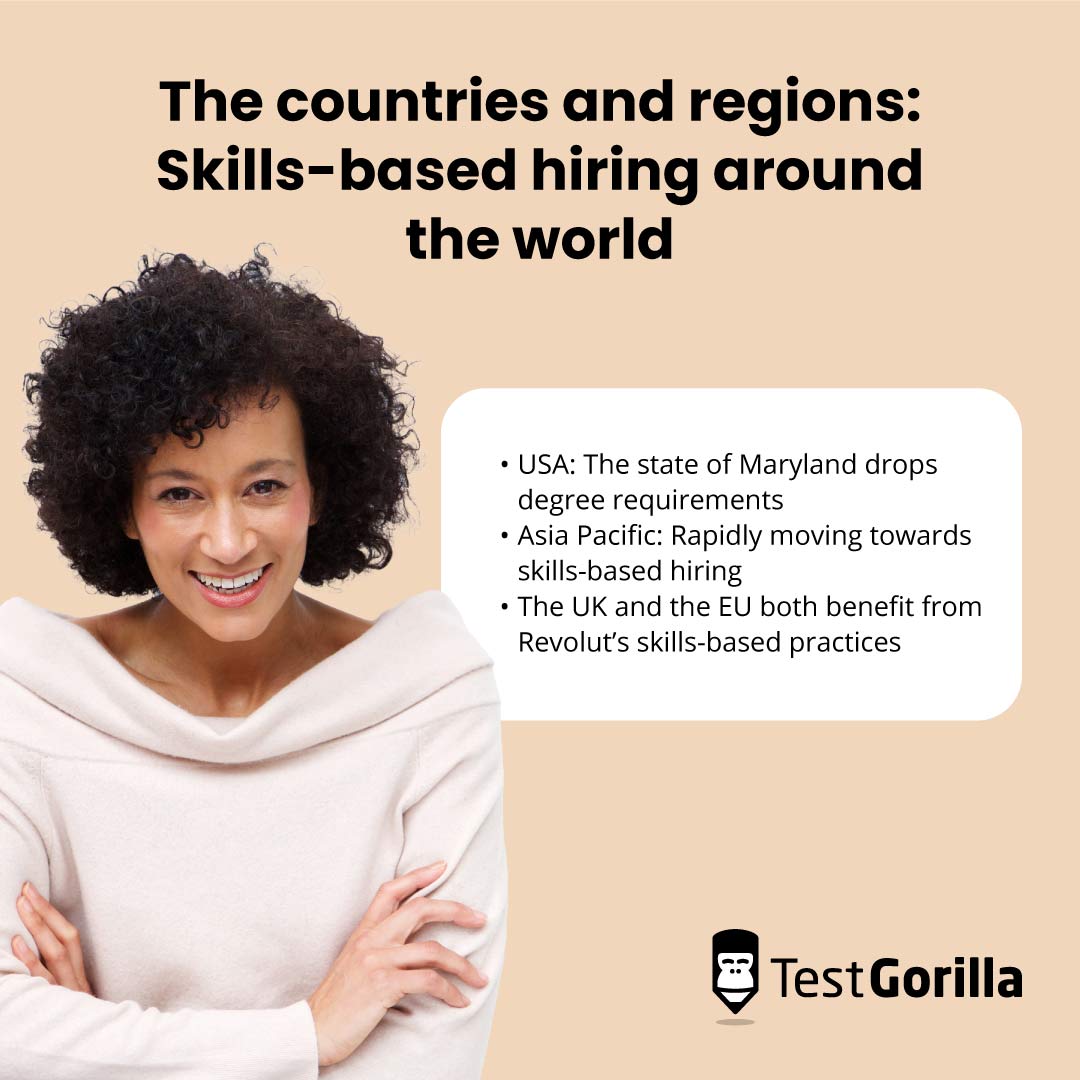
7. Maryland, USA
In 2022, the state of Maryland dropped four-year degree requirements for thousands of jobs in the government sector.
The aim of this initiative was to draw attention to the value of alternative credentials and experience. State officials want to give people a better shot at securing a stable, fulfilling job.
Governor Larry Hogan was quoted as saying:
“[W]e are ensuring qualified, non-degree candidates are regularly being considered for these career-changing opportunities.”[3]
Over 38,000 people work for the state of Maryland and it’s estimated that more than half of those jobs can be performed by people whose alternative skill routes can easily substitute for a college education.
These alternative routes include:
Life experience
Non-relevant job experience
Hobbies and volunteer work
Alternative training
Community college education
Maryland estimates that about 47% of its working population are STARs (skilled through alternative routes). That’s 2.8 million workers, and these people need solid opportunities – opportunities that they can access through skills-based hiring.
To learn more about how unnecessary degree requirements are holding top talent back, read our blog on degree inflation .
8. Indiana, USA
Indiana’s tech leaders are struggling to attract and retain great talent. They’re facing a major skill shortage and they can’t solve it with the “usual” hiring methods.
Traditional recruiting methods exclude over 95% of Indiana’s workforce.
Indiana has a workforce of 3,332,239 people, but consider this:
A four-year degree requirement removes 75%
Biases can eliminate up to 30% of the pool
Requiring specific past experience removes 93% of the talent pool
With all of that in mind, a pool of more than three million candidates is reduced to just over 42,000.
Indiana’s Office of Technology (IOT) realized that skills-based hiring practices could fix this problem and solve their shortage.
They started by removing degree requirements from most job descriptions, then took the next step and started offering reskilling opportunities to workers from alternative industries, such as line cooks and truck drivers.
Tracy Barnes, IOT’s chief information officer, said that the results of the program have been positive and they’re “very pleased” so far. She also said that she’s equally excited to see the positive life impacts for the candidates involved.
9. Asia-Pacific
Skills-based hiring is quickly gaining traction in the Asia-Pacific area.
One study showed that 79% of businesses in the Asia-Pacific area look for skills when hiring versus the 21% that prioritize education and experience.[4]
The same study found that internal mobility is more important than ever and that companies want to prioritize gender equality and disability inclusion . These points can also be accomplished by adopting skills-based hiring.
Asia-Pacific is looking to skills-based practices to improve the future of their recruitment processes, but Singapore-based TruTrip is already reaping the benefits .
TruTrip is a business travel management company that needed help assessing candidate skills and hiring the best candidates, so they gave TestGorilla a try.
Here are a few ways that TestGorilla’s pre-employment skills testing helped TruTrip’s recruitment processes:
Gives them a way to objectively assess applicants’ skills and knowledge
Helps them eliminate bias from the hiring process
Enables them to consistently make better hiring decisions
Reduces their reliance on resume screening
Enhances teamwork and communication
Improves the employee experience of new hires
According to Hugh Batley, the founder of TruTrip, their new hires are a better fit. These employees become great contributors and have a better initial experience with the company.
TestGorilla also helps TruTrip save thousands of dollars by reducing the chances of a costly mis-hire.
This isn’t unusual. According to TestGorilla’s State of Skills-Based Hiring report, 92.5% of organizations using skills-based practices saw a reduction in mis-hires in 2022.
10. The UK and the EU
The UK and the EU have developed a strong focus on skills over the past few years.
Interest in skills-based hiring in the UK rose 63% from 2021 to 2022 . This drastic increase is due to employers wanting a wider talent pool and candidates prioritizing and valuing their alternative experience.
This move is helping job opportunities reach the 73.6% of people in the United Kingdom who don’t possess a four-year degree. [5]
As for the European Union, they developed the “Pact For Skills” program in 2020. This program was created to encourage and fund better upskilling and reskilling while also promoting greater diversity and gender equality.[6]
A good example from both areas is the British-Lithuanian bank, Revolut.
Revolut adopted skills-based hiring by using TestGorilla’s skills tests and, as a result, improved their time-to-hire by 40% .
Among many other benefits, Revolut found TestGorilla’s language tests life-saving. Assessing language proficiency is essential for a multinational company, but traditional methods are time-consuming and laborious.
TestGorilla’s language tests help Revolut to quickly and easily evaluate their candidates’ reading, writing, listening, and speaking skills. This helped them to nearly fully automate their screening process, improving time-to-hire greatly.
To read more case studies and success stories about skills-based hiring, check out our 10 stories that demonstrate the power of skills-based hiring or our collection of customer case studies .
Here are 3 top picks from our case studies:
Revolut improves time-to-hire by 40% using TestGorilla
Design Pickle uses TestGorilla to boost application completion rate by 25%
TestGorilla helps TruTrip to save money and improve employee experience
If you’d like to acquaint yourself with a solid skills-based hiring practice, browse our test library and review our skills tests.
“JVS 2022 Impact Report”. (2022). JVS . Retrieved March 6, 2023. https://impact2022.jvs.org/
“Maria Black, president and CEO”. (n.d). Business Roundtable. Retrieved March 6, 2023. https://www.businessroundtable.org/about-us/members/maria-black-president-and-ceo-adp
McGraw, Mark. (April 4, 2022). “Dropping Degree Requirements: Do Employers Still Care About Education?”. World at Work . Retrieved March 6, 2023. https://worldatwork.org/resources/publications/workspan-daily/dropping-degree-requirements-do-employers-still-care-about-education
“The Future of Talent”. (2021). LinkedIn . Retrieved March 6, 2023. https://business.linkedin.com/content/dam/me/business/en-us/talent-solutions/resources/pdfs/future-of-talent-whitepaper.pdf
“Overview of the education system”. (2022). Education GPS . Retrieved March 6, 2023. https://gpseducation.oecd.org/CountryProfile?primaryCountry=GBR&treshold=10&topic=EO
“Pact for Skills”. (November 10, 2020). European Commission . Retrieved March 6, 2023. https://ec.europa.eu/social/main.jsp?catId=1517&langId=en
Related posts

How to write a project manager job description

9 steps to effective competency mapping

AI is not ready to interview job applicants. Here’s why.
You've scrolled this far
Why not try TestGorilla for free, and see what happens when you put skills first.

Latest posts

The best advice on pre-employment testing, in your inbox.
No spam. Unsubscribe at any time.
Hire the best. No bias. No stress.
Our screening tests identify the best candidates and make your hiring decisions faster, easier, and bias-free.
Free resources

This checklist covers key features you should look for when choosing a skills testing platform

This resource will help you develop an onboarding checklist for new hires.

How to assess your candidates' attention to detail.

Learn how to get human resources certified through HRCI or SHRM.

Learn how you can improve the level of talent at your company.

Learn how CapitalT reduced hiring bias with online skills assessments.

Learn how to make the resume process more efficient and more effective.

Improve your hiring strategy with these 7 critical recruitment metrics.

Learn how Sukhi decreased time spent reviewing resumes by 83%!

Hire more efficiently with these hacks that 99% of recruiters aren't using.

Make a business case for diversity and inclusion initiatives with this data.
This site uses cookies to improve your experience. By viewing our content, you are accepting the use of cookies. To help us insure we adhere to various privacy regulations, please select your country/region of residence. If you do not select a country we will assume you are from the United States. View our privacy policy and terms of use.
- Employee Benefits
- Change Management
- Talent Acquisition
- Applicant Tracking Systems

7 Steps to Building a Successful Talent Acquisition Team (+Netflix Case Study)
Analytics in HR
AUGUST 8, 2023
Talent acquisition team structure Examples of organizations’ talent acquisition team structures 7 Steps for building a talent acquisition team How to measure the success of a talent acquisition team Case study : Netflix’s talent acquisition team What is a talent acquisition team?
15 HR Analytics Case Studies with Business Impact
NOVEMBER 5, 2018
For this article, I have collected 15 of the best HR analytics case studies I’ve come across in the past two years. Each of these case studies are connected with a concrete business impact. For each case study , I will refer to their original publication. 15 HR Analytics Case Studies .
This site is protected by reCAPTCHA and the Google Privacy Policy and Terms of Service apply.
- How to Onboard New Hires in 10 Minutes or Less
- How To Empower Your Workforce With Modern Fertility Benefits
- Mastering Remote Onboarding: Proven Strategies for Seamless New Hire Integration
- Engage, Empower, Excel: Transforming Performance in the New Era of Work
- Diversity Recruiting 101: How To Attract And Retain Talent In 2025
MORE WEBINARS
Trending Sources
- EmployeeConnect
- Engage2Excel
- UrbanBound HR

Case Study: Strategic Workforce Planning for Rail Infrastructure Managers
MARCH 30, 2020
In this case study , strategic workforce planning is applied to solve this national problem, impacting millions of commuters. The TWP process estimates the turnover in the coming 18 months to plan and execute required recruiting efforts, rigorous psychological testing, and 9 months of training periods for new employees.

Children’s Mercy Hospital Case Study
Stories Incorporated HR
APRIL 8, 2020
Want this case study as a PDF? How Children’s Mercy is Using Content to Drive Recruiting Efforts. For example , nursing job descriptions now start with a call to action, not to apply, but to watch a video to hear the experiences of their nursing staff. Reading Time: 6 minutes. Find it here !

Finding the Best California SaaS Software Recruiters: A Comprehensive Guide
Recruiters Lineup
AUGUST 10, 2024
However, recruiting in this space isn’t just about filling roles; it’s about finding experts who can drive innovation and growth. The challenges of sourcing skilled professionals in this fast-paced market are unique, requiring recruiters specializing in the nuances of SaaS.

What is HR Analytics? All You Need to Know to Get Started
FEBRUARY 28, 2024
This has a significant impact on organizational performance , leading to as much as a 25% rise in business productivity, a 50% decrease in attrition rates, and an 80% increase in recruiting efficiency. Example : Annual employee turnover rate.) Example : Examining unplanned absence data to identify absenteeism drivers.)

13+ HR Case Studies: Recruiting, Learning, Analytics, and More
SEPTEMBER 3, 2019
As someone who has worked in the HR profession, I know well the full value of stories, examples , and case studies . While much of the work we do at Lighthouse Research & Advisory focuses on quantitative research studies , we do a fair amount of qualitative research as well. How to Lead a Hiring Team.
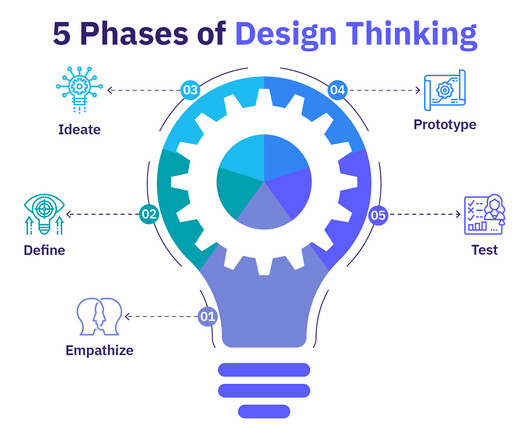
How To Apply Design Thinking in HR (+ 3 Case Studies)
AUGUST 16, 2023
The benefits of a design thinking approach in HR The 4 principles and 5 phases of design thinking 4 Ways to apply design thinking to HR processes Successful implementation of design thinking in HR Design thinking in HR examples What is design thinking? Recruitment and onboarding Consider how candidates experience the recruitment process.

Recruiting Feedback Case Study: The Recruiting Revenue Connection
MARCH 11, 2019
In our latest recruiting feedback case study , Craft Brew Alliance (CBA) demonstrates that asking the right questions at the right time can dramatically affect overall recruiting effectiveness AND uncover powerful connections between recruiting and revenue generation. Recruiting and Revenue.
Using Talent Sourcing Platforms To Save Recruiter Time
Select Software Reviews
MAY 17, 2019
Talent sourcing has become an incredibly important part of any recruiting strategy. In response, recruiters have been forced to rely more and more on outbound means to engage potential hires. Full desk recruiters don’t want to source. Source cfo.com. Sourcing is all these companies do.

Finding the Perfect Fit: How Finance Recruiters Can Help Hiring Managers and Job Seekers
Professional Alternatives
FEBRUARY 2, 2024
[link] Finding the Perfect Fit: How Finance Recruiters Can Help Hiring Managers and Job Seekers The role of finance recruiters in the job market The job market can be a daunting place for both hiring managers and job-seeking candidates, especially in the highly competitive field of finance.

The Evolution of HR with AI Technologies
FEBRUARY 19, 2024
Traditionally, HR departments focused on managing employee records, overseeing recruitment processes, and ensuring compliance with labor laws. One of the most significant changes was in recruitment and talent acquisition. Case studies from various companies show the success of integrating AI into HR strategies.

Case Study: MarketGap’s Innovative Strategy for Agile Workforce Evolution
JUNE 30, 2023
Partnering with organizations and agencies that focus on promoting minority talents, such as minority professional associations and diversity-focused recruitment firms. The post Case Study : MarketGap’s Innovative Strategy for Agile Workforce Evolution appeared first on Hppy.

Case study: Executing a recruitment marketing video plan
MAY 19, 2021
Executing a recruitment marketing video plan sometimes requires research and buy-in. This case study is an excerpt from our new ebook, Getting Buy-In for Your Employee Story Project: The Ultimate Guide to Employer Branding and Recruitment Marketing ROI. Reading Time: 7 minutes. Brittni says, “I knew Stories Inc.

OKR Examples: How to Write OKRs that Drive Impact
OCTOBER 19, 2022
In this article, we’ll break down the framework for writing impactful objectives and key results and share some OKR examples you can use as a guide when crafting your own. Example of a poorly-written objective: Provide better customer service. Example of poorly-written key results: Treat our customers well every day.

9 Digital HR Case Studies with Business Impact
Digital HR Tech
OCTOBER 23, 2019
In this article, we have collected some of the best Digital HR case studies we’ve come across. They’re good examples of organizations that really get Digital HR and make the most of it. Each case study is connected to a specific business imperative. What’s in? Anchor Trust 2. Deloitte 5.

Case Study: Credit Union
OCTOBER 1, 2020
Today’s case study explains how TimeSimplicity can help a typical small credit union maintain quality customer service while controlling operating expenses through automated credit union employee scheduling. Our example organization is Springfield Community Credit Union. How much can you save? ArticleID 7414.
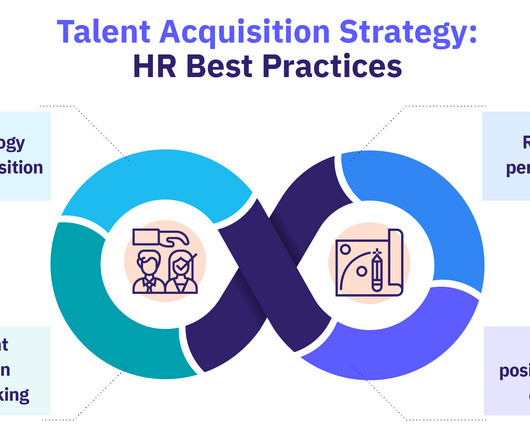
Develop Your Talent Acquisition Strategy With 6 Practical Examples
JULY 31, 2023
In this article, we’ll explore what a talent acquisition strategy looks like, how to develop a talent acquisition strategy, along with some best practices and examples to help you move your company forward. Software and applicant tracking systems can help you sort through your talent pool, assess candidates, and recruit .

Why You Shouldn’t Start Job Ads with ‘About Us’: Best Tips to Boost Recruitment
AUGUST 21, 2024
That meant recruiters had to learn new skills and competencies, like applying data-driven AI solutions that sped up the hiring process in the face of skill shortages. Rather, it could signal a crossroads to rethink your hiring and recruitment strategy. Essentially, this plays an active part in business intelligence initiatives.

Creating Employment Opportunities With Flex Manufacturing (i4cp login required)
MARCH 7, 2023
This case study represents one of the submissions for i4cp's 2023 Next Practice Awards, winners will be honored at the i4cp 2023 Next Practices Now Conference. You can also view other Next Practice Award case studies . A cross-functional team formed to include the Director of Manufacturing, his HRBP and Recruiting .

Case Study: The Value Of Pay Transparency And How To Implement It
HR Tech Girl
JULY 5, 2023
Here I aim to shed light on what pay transparency looks like at Compt, explain its mechanics and influence on overall compensation structures and raises, present real-world examples of its benefits, and provide practical considerations for organizations contemplating this approach.
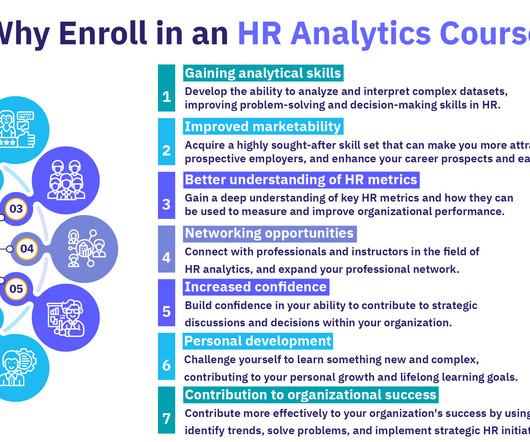
13 HR Analytics Courses Online To Check Out in 2024
FEBRUARY 23, 2024
All subjects are illustrated by real-life examples of how various organizations tap into HR analytics techniques to help them flourish. A dashboard example is included below. It includes facilitated discussions, case studies , group and individual activities, and self-assessments. Want to know more?

Healthcare HR and Nursing Leaders: Partnering for Improved Outcomes
FEBRUARY 11, 2019
Creating a partnership between nursing leaders and HR, though, can help organizations do a better job recruiting and retaining nurses, leading to better workforce management for HR and improved care for patients. With a projected nursing shortage in the next decade , recruitment has never been more important for healthcare organizations.

Recruit Better: Employee Discount Programs and Taxes
HR Bartender
APRIL 16, 2017
Examples of de minimis perks include occasional tickets to theatres and sporting events, as well as invitations to company-hosted parties and picnics. That helps strengthen relationships and increase engagement with employees, and it can serve as a competitive differentiator and recruitment tool.

How to Identify Bottlenecks in Your Recruitment Process
DECEMBER 9, 2014
Take recruiting for example . When the recruiting process is broken, everybody knows it. And in my experience, everyone blames everything on recruiting being broken. “We Problems (or contraints) in recruiting isn’t something to ignore because finding top talent is essential to the business.

What is HR Automation? A Guide with Practical Examples
APRIL 8, 2021
HR is responsible for recruiting , onboarding and offboarding employees, training and development, payroll and timekeeping, tracking vacation and sick days, and employees’ general well-being within the organization. Benefits of HR automation Examples of HR automation in action The best HR automation tools currently on offer.
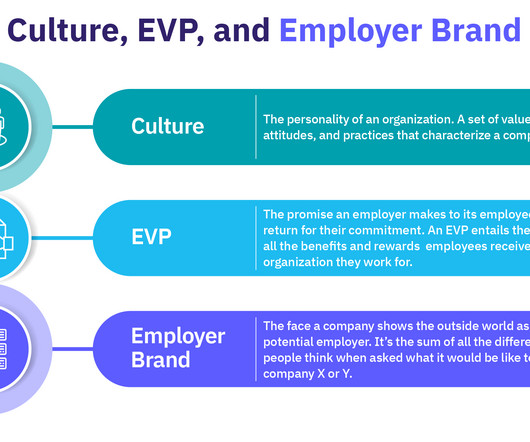
13 Great Employer Branding Examples To Inspire You in 2024
SEPTEMBER 15, 2023
In this article, we’ll share 13 exceptional employer branding examples and what we like about them to inspire you in building your employer branding strategy. Types of employer branding content Employer branding examples 1. Now, let’s dive into the best employer branding examples ! Contents What is employer branding?

People Analytics and HR-Tech Reading List
Littal Shemer
OCTOBER 11, 2022
“The book helps professionals, researchers, employers, and everybody interested in the world of work to understand the past, present, and future of recruitment . . “The book helps professionals, researchers, employers, and everybody interested in the world of work to understand the past, present, and future of recruitment .

Navigating Uncertainty: The Strategic Imperative of Investing in People and HR Tech
FEBRUARY 7, 2024
Optimizing Operations HR tech serves as a catalyst for operational efficiency, streamlining processes such as recruitment , onboarding, and performance evaluation. This collection of case studies showcases success stories where savvy UAE companies harnessed the power of HR tech to drive out of the box results: 1.
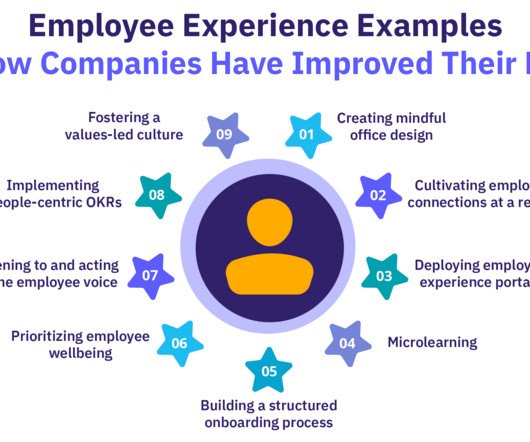
9 Inspiring Employee Experience Examples To Boost Your EX
JANUARY 12, 2024
These touch points are encounters with your policies, processes, and strategies from the first contact during recruitment to the offboarding and alumni policies. One of the best ways to learn is to look at specific employee experience examples , case studies , and initiatives deployed in other organizations. Contents 1.

Why talent acquisition pros must learn to analyze data, according to a new book
HRExecutive
MARCH 25, 2024
The consulting firm also found that most HR departments use two or more platforms to facilitate the recruiting process. Throughout the chapters, practical examples and case studies from organizations across the globe provide real-world context. “We A study performed by St.

Trend: Candidate Feedback for Recruiter Reviews and Managing Recruiters
JANUARY 13, 2023
Using candidate feedback for recruiter reviews and managing recruiters is fast becoming standard practice these days. In fact MOST Survale clients use some form of candidate and/or hiring manager feedback in quarterly or annual recruiter reviews, incentive compensation or other systems for managing recruiters ’ performance.

A Real Life Example: The Benefits of Recruiting Chatbots
SelectSoftware
APRIL 28, 2020
If you’re looking to save time with your recruiting efforts, check out this case study .
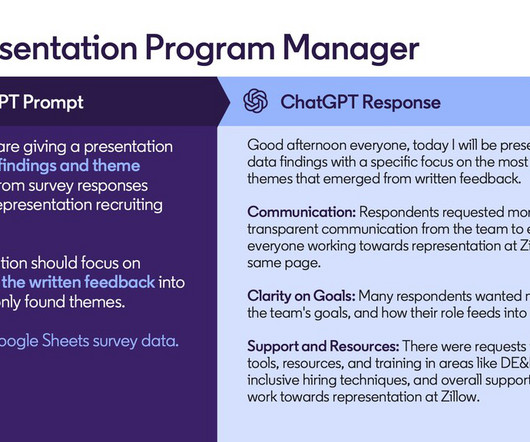
5 Ways to Revolutionize Recruiting with AI
Linkedin Talent Blog
DECEMBER 6, 2023
Namely, it gives recruiters more time for the human aspects of their work. “AI In one example , the team prompted the AI to “Act as if you’re giving a presentation on key data findings and theme takeaways from survey responses around our representation recruiting survey.” million job applications.
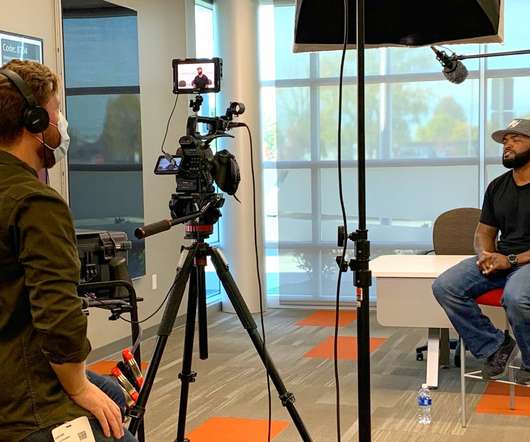
Best recruitment marketing blogs of the year by Stories Inc.
DECEMBER 22, 2020
At the start of 2020, we focused on providing for you the best recruitment marketing blogs possible. All in all, we hit “publish” over 100 times this year— including virtual content creation resources , a COVID-19 hub , case studies , downloadables , and original articles. Crisis communications for recruitment marketers.

Recruiting in the Era of International Accounting Standards: A Hiring Manager’s Handbook
FEBRUARY 9, 2024
Partnering with a Global Accounting Recruitment Agency Navigating the global accounting landscape and finding top talent can be a daunting task. One effective solution is to partner with a global accounting recruitment agency. Ready to elevate your expertise and drive success in global accounting?

Gamification in the Workplace: Stats, Engagement, and Examples (Survey)
OCTOBER 9, 2019
The most simple example is that of customers earning (digital) loyalty points unlocking a reward once they’ve reached a certain level. How employees experience gamification Gamification, motivation, and engagement Examples of gamification at work Recruitainment FAQ. Examples of gamification at work. What is gamification?

Improving Diversity Recruiting Strategy: 7 Practical Tips
SEPTEMBER 8, 2020
People say that using a diversity recruitment strategy is the right thing to do. This post is here for companies that need to improve their diversity recruiting strategy and take advantage of these benefits. By the time you’re done reading, you’ll know what it takes to recruit top diverse talent and retain them effectively.

Talent Mobility Webinar: How to Recruit and Retain Internal Talent
NOVEMBER 7, 2016
Recruiting : instead of immediately looking externally for talent, you consider your internal talent inventory to determine if you have someone you can move into the role. Each case study tells a slightly different story, and I’m excited to share those examples . It has a whole host of impacts and benefits.

Employer Branding and EVP: 3 Ways Sky Does it Right (case study)
JULY 3, 2019
.’ In this episode, host Jörgen Sandberg talks with Sophie Holmes, Head of Employer Brand Attraction at Sky and as such responsible for everything from employer brand to attracting great talent and the candidate experience across the entire recruitment process. How do we embed this in our recruitment team? The channels you use.

Organizations Can Use Assessments to Bridge the Skills Gap
SEPTEMBER 5, 2017
According to the Society for Human Resource Management (SHRM) report “ The New Talent Landscape: Recruiting Difficulty and Skills Shortages ”, 68 percent of HR professionals are having trouble recruiting candidates for full-time positions. Organizations Can Use a 3-Strategy Approach to Recruitment . Enjoy the post!).

Case Study Underscores Why HR Change Management Skills Are Critical
HR Daily Advisor
DECEMBER 8, 2017
Here is an example to illustrate the point: This is a true story about Robert, a director of Recruitment and Human Development for a major chemical company. Improve the company’s college recruiting program designed to bring into the company “high potential” entry-level engineers and technically-trained individuals.

Maximizing Talent Acquisition Success: The Qualigence and Valvoline Partnership
Qualigence Blog
MARCH 14, 2024
This blog explores the transformative partnership between Qualigence, a leader in recruitment and talent strategy, and Valvoline, a highly respected automotive services and products provider. Resource Augmentation : Leveraging additional full-cycle recruiting resources to enhance Valvoline’s recruitment capabilities.

#GamifyHR HR / Learning Gamification Case Studies
Strategic HCM
MAY 18, 2014
Day 3 of Fleming''s Gamification in HR Summit focused on learning, particularly in this case study from Tuba Surucu from Yapi Kredi Bank in Turkey. So again, this is gaming rather than gamification - and quite similar to the recruitment case studies in fact.
Stay Connected
Join 398,000+ Insiders by signing up for our newsletter
- Participate in Human Resources Today
- 2019 Human Resources Today Summer Reading List
- Stay At Home Reading List
- Add a Source
- Add a Resource
- See All
- 2018 Human Resources Today MVP Awards
- 2017 Human Resources Today MVP Awards
- 2019 Human Resources Today MVP Awards
- 2020 Human Resources Today MVP Awards
- 2021 Human Resources Today MVP Awards
- 2022 Human Resources Today MVP Awards
- Mon. Aug 26
- Sun. Aug 25
- Sat. Aug 24
- Fri. Aug 23
- Aug 17 - Aug 23
- Employee Engagement
- Onboarding Software
- Talent Management
- Performance Management
- Time and Attendance
- More Topics

Input your email to sign up, or if you already have an account, log in here!
Enter your email address to reset your password. a temporary password will be e‑mailed to you., be in the know on.
Human Resources Today
Expert insights. Personalized for you.
We organize all of the trending information in your field so you don't have to. Join 398,000+ users and stay up to date on the latest articles your peers are reading.

Get the good stuff
Subscribe to the following Human Resources Today newsletters:
You must accept the Privacy Policy and Terms & Conditions to proceed.

You know about us, now we want to get to know you!
Check your mail, we've sent an email to . please verify that you have received the email..
We have resent the email to
Let's personalize your content
Use social media to find articles.
We can use your profile and the content you share to understand your interests and provide content that is just for you.
Turn this off at any time. Your social media activity always remains private.
Let's get even more personalized
Choose topics that interest you., so, what do you do.
Are you sure you want to cancel your subscriptions?
Cancel my subscriptions
Don't cancel my subscriptions
Changing Country?
Accept terms & conditions.
It looks like you are changing your country/region of residence. In order to receive our emails, you must expressly agree. You can unsubscribe at any time by clicking the unsubscribe link at the bottom of our emails.
You appear to have previously removed your acceptance of the Terms & Conditions.

We noticed that you changed your country/region of residence; congratulations! In order to make this change, you must accept the Aggregage Terms and Conditions and Privacy Policy. Once you've accepted, then you will be able to choose which emails to receive from each site .
You must choose one option
Please choose which emails to receive from each site .
- Update All Sites
- Update Each Site
Please verify your previous choices for all sites
Sites have been updated - click Submit All Changes below to save your changes.
We recognize your account from another site in our network , please click 'Send Email' below to continue with verifying your account and setting a password.
You must accept the Privacy Policy and Terms & Conditions to proceed.
This is not me
- Browse All Articles
- Newsletter Sign-Up
Recruitment →

- 09 Jul 2024
- Research & Ideas
Are Management Consulting Firms Failing to Manage Themselves?
In response to unprecedented client demand a few years ago, consulting firms went on a growth-driven hiring spree, but now many of these firms are cutting back staff. David Fubini questions whether strategy firms, which are considered experts at solving a variety of problems for clients, are struggling to apply their own management principles internally to address their current challenges.
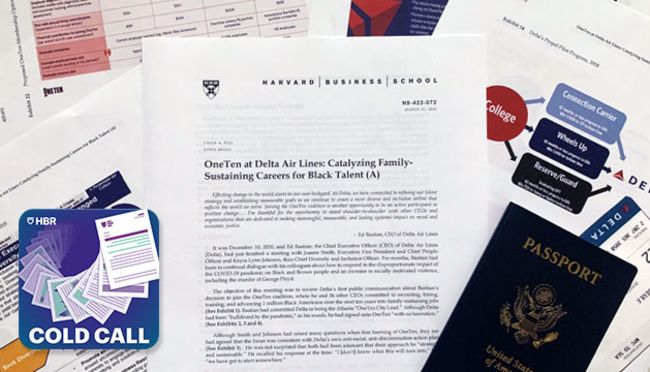
- 21 Nov 2023
- Cold Call Podcast
Cold Call: Building a More Equitable Culture at Delta Air Lines
In December 2020 Delta Air Lines CEO Ed Bastian and his leadership team were reviewing the decision to join the OneTen coalition, where he and 36 other CEOs committed to recruiting, hiring, training, and advancing one million Black Americans over the next ten years into family-sustaining jobs. But, how do you ensure everyone has equal access to opportunity within an organization? Professor Linda Hill discusses Delta’s decision and its progress in embedding a culture of diversity, equity, and inclusion in her case, “OneTen at Delta Air Lines: Catalyzing Family-Sustaining Careers for Black Talent.”

- 14 Nov 2023
- What Do You Think?
Do We Underestimate the Importance of Generosity in Leadership?
Management experts applaud leaders who are, among other things, determined, humble, and frugal, but rarely consider whether they are generous. However, executives who share their time, talent, and ideas often give rise to legendary organizations. Does generosity merit further consideration? asks James Heskett. Open for comment; 0 Comments.

- 07 Nov 2023
When Glasses Land the Gig: Employers Still Choose Workers Who 'Look the Part'
Is an eyeglass-wearer more likely to be a strong web developer? Employers that use online talent platforms tend to consider profile photos in final hiring decisions, says research by Isamar Troncoso. What's the role of recruiting platforms in preventing bias?

- 16 Oct 2023
Advancing Black Talent: From the Flight Ramp to 'Family-Sustaining' Careers at Delta
By emphasizing skills and expanding professional development opportunities, the airline is making strides toward recruiting and advancing Black employees. Case studies by Linda Hill offer an inside look at how Delta CEO Ed Bastian is creating a more equitable company and a stronger talent pipeline.

- 26 Sep 2023
Unpacking That Icky Feeling of 'Shopping' for Diverse Job Candidates
Many companies want to bring a wider variety of lived experiences to their workforces. However, research by Summer Jackson shows how hiring managers' fears of seeming transactional can ultimately undermine their diversity goals.

- 21 Aug 2023
You’re More Than Your Job: 3 Tips for a Healthier Work-Life Balance
Younger workers are rejecting the idea of sticking with one employer for the long haul and are instead finding happiness by job-hopping and creating dramatically different boundaries with work. In a new book, Christina M. Wallace maps out a step-by-step guide to building a flexible and fulfilling life that includes rest, relationships, and a rewarding career.

- 26 Jul 2023
STEM Needs More Women. Recruiters Often Keep Them Out
Tech companies and programs turn to recruiters to find top-notch candidates, but gender bias can creep in long before women even apply, according to research by Jacqueline Ng Lane and colleagues. She highlights several tactics to make the process more equitable.

- 18 Apr 2023
The Best Person to Lead Your Company Doesn't Work There—Yet
Recruiting new executive talent to revive portfolio companies has helped private equity funds outperform major stock indexes, says research by Paul Gompers. Why don't more public companies go beyond their senior executives when looking for top leaders?

- 31 Jan 2023
It’s Not All About Pay: College Grads Want Jobs That ‘Change the World’
Many college graduates will accept lower salaries for roles that have the potential to give back to society, says research by Letian Zhang. Could trading pay for altruism help shrink the income gap?

- 05 Dec 2022
5 Companies Where Employees Move Up the Ladder Fast
IBM, Southwest Airlines, and other companies proactively help workers advance their careers to try to retain them, says research by Joseph Fuller. The findings show just how important an employer can be to future salary and job prospects.

- 30 Nov 2022
Recruiters: Highlight Your Company’s Diversity, Not Just Perks and Pay
Many job seekers want to join inclusive companies that reflect their values. Research by Joseph Pacelli shows how employers can attract more talent by promoting the diversity of their workforce.

- 22 Apr 2022
Companies Can Expand Their Talent Pool by Giving Ex-Convicts a Second Chance
People with criminal convictions often have trouble finding work and face double-digit unemployment rates. Yet employers would be more willing to hire them under certain conditions, says research by Zoë Cullen. Open for comment; 0 Comments.

- 05 Nov 2021
How to Tap the Talent Automated HR Platforms Miss
Companies are struggling to fill open positions, but the job platforms they use often screen out promising candidates just because they don't tick every box. Joseph Fuller probes the challenges—and opportunities—of "hidden workers." Open for comment; 0 Comments.

- 08 Dec 2020
Why Companies Hunt for Talent on Digital Platforms, Not in Resume Piles
Rather than sit back and wait for applicants to send resumes, companies are proactively targeting prospective employees on digital platforms and social media, often with a recruiter's help, says research by Rembrand Koning. Open for comment; 0 Comments.

- 17 Nov 2020
Why a Blended Workforce May Be Key to Lasting Competitive Advantage
Companies are increasingly blending full-time staff with skilled on-demand talent. The problem: Few companies have developed cultures that accommodate gig workers, says Joseph B. Fuller. Open for comment; 0 Comments.
- 30 Jun 2020
Is a Business School-Industry Collaboration Needed to Attract Black Talent to Campus?
SUMMING UP:James Heskett's readers suggest that recruiting minority students to business school must be matched with programs to retain them. Open for comment; 0 Comments.
- 01 May 2020
Does Remote Work Mix with Organizational Culture?
SUMMING UP: Readers who themselves work from home think differently about how organizations should respond to remote work initiatives. James Heskett sums up the dicussion. Open for comment; 0 Comments.

- 13 Nov 2019
- Working Paper Summaries
The Gender Gap in Self-Promotion
Many organizations and job applications require individuals to assess their own ability and performance. When women communicate to potential employers, however, they systematically give less favorable assessments of their own past performance and potential future ability than equally performing men. The study rules out potential explanations for the gap and discusses implications.

- 05 Sep 2019
- Sharpening Your Skills
Making the Right Technical Hire
CEOs are usually more comfortable making key hires on the business side of the house than the technology side. Here is what executives need to understand about technical hires, according to Julia Austin. Open for comment; 0 Comments.
Dr John Sullivan Talent Management Thought Leadership
Amazon recruiting – a case study of a giant among children.
January 17, 2022
Compare their results to all others, and you too will call Amazon… A Giant Recruiting Machine.
Note this case study is designed for quick scanning.
Yes, Amazon recruiting is in a class by themselves because they relentlessly hire when others cry for applicants. Of course, I don’t loosely use the phrase “A giant among children.” However, after doing numerous corporate case studies over the years covering other recruiting powerhouses (including Google, Apple, and Facebook). I quickly found that their record recruiting volumes across a broad range of jobs and locations could only be labeled as breathtaking. And just by chance, if you think that I’m not giving enough credit to most other corporate recruiting functions (even Google pales in comparison). You should realize that only a mere 18% of HR professionals even describe their own recruiting function as “top-notch” or “advanced.”
| – during our severe labor shortage in 2021. Amazon hired a record-breaking 500,000 employees worldwide, actually doubling the previous year’s hiring total (the previous recruiting leader Google hired a mere 20,000.) In addition, literally, everyone wants to work there. Because LinkedIn named Amazon as the #1 place for US workers in 2021. They are so popular that they received an astonishing 30 million job applications (that’s not a typo) for their open jobs, 10 times the previous 3 million record at Google. Last year Amazon even received a record 1 million applications during a single week! |
The Six Pillars Of Recruiting Excellence At Amazon
This Amazon case study reveals the many factors that cause Amazon’s recruiting function to be so far ahead of the competition. They are truly a giant because they excel in each of the six pillars of excellence in recruiting. The six pillars that make Amazon so successful are:
- Their recruiting impacts business results
- Their proven capability of handling huge recruiting volumes across a wide range
- Their fanatical insistence on quality hires
- A scientific data-driven recruiting approach is the foundation of their success
- They utilize a one-size-fits-one agile hiring process
- Their targeted recruiting sub-programs are second to none
Let’s jump immediately to the first and most important strategic pillar – Amazon’s record-breaking strategic business and recruiting results.
Pillar #1. Amazon’s Recruiting Impacts Business Results
Amazon recruiting is aiming to go beyond simply producing recruiting results. And to also directly impact their corporation’s business results. Those results include:
- Hiring is the single most important element in Amazon’s business success – Jeff Bezos made it clear. “Setting the bar high in our approach to hiring has been, and will continue to be, the single most important element of Amazon.com’s success” (that’s not just the most important HR function, but the most important business function). Jeff began making this recruiting priority clear in the company’s very first annual shareholder letter in 1998. Most other corporations don’t admit this reality. But, it’s simply not possible for a large corporation to innovate and grow rapidly without fully funded exceptional recruiting.
- Yet with all this emphasis, recruiting remains their primary challenge – The CFO recently publicly revealed that even with its current high priority, recruiting maintains a primary challenge. When he noted, for example, in the package movement area, “The availability of workers is Amazon’s primary challenge .” Rather than resting on their laurels, they realize that they continuously need to get much better is a primary reason they continue to improve in recruiting.
- Amazon’s size and growth are made possible by its excellence in recruiting – the prime limiting factor that restricts the company from maintaining its quantum growth rate is the ability to successfully recruit a huge volume of employees each year. And because Amazon employs about 1.4 million people globally , they have already done a high recruiting volume. The employee headcount makes them the US’s second-largest private employer (after Walmart). I predict that they will soon surpass Walmart for the #1 spot as the largest employer in the US. I would also note that Amazon has helped to reduce unemployment. Because of the 400,000 people they hired for their U.S. operations network, 45% were previously unemployed. Their new CEO, Andy Jassy, reinforced the importance of continuous growth through recruiting by announcing that he was planning to hire 55,000 people for corporate and technology roles globally during his first months. That’s close to all of Facebook’s current headcount and nearly 1/3 of Google’s headcount.
- Recruiting has made a major contribution to its stock value – businesswise, their recruiting and operational excellence have directly contributed to the corporation’s incredibly high stock valuation. Currently, Amazon is the fifth most valuable global company in market cap valuation, nearly 1.65 Trillion dollars.
- Recruiting has made a major contribution toward having an extremely productive workforce – the average revenue generated by each employee last year was $353,000, which is an amazing ROI. HR helped maintain that productivity by increasing management prerogatives by remaining a 100% union-free workforce.
| Amazon demonstrated how important recruiting was to its business in July 2012. They replaced the normal consumer-focused primary website front page and populated it with only a Jeff Bezos signed recruiting letter addressed to its customers. That letter announced to that it was hiring and instituting a new jobs initiative (its Career Choice Program). |
————————————————-
Pillar #2. A proven capability for handling a huge volume of recruiting across a broad range of positions and locations
Amazon recruiting has proven over the years that it has the capability of recruiting a huge number of new hires across many different job families and locations.
- Recruiting volume and capability are second to none – the fact that during 2021 Amazon’s recruiting increased headcount by a whopping 63% in a single year. The largest percentage increase in headcount ever accomplished by any large employer during peacetime! This is but one startling indication of recruiting’s agility and capability to ramp up their recruiting capability dramatically. Amazon, of course, must have an exceptional recruiting capability because it is America’s second-largest employer (and I predict that it will soon surpass Walmart). The workload handled by their recruiting function is unparalleled because it has as many as 30,000 openings at a single time.
- Powerful Employer Brand means that everyone considers them – it is clear that because of its HR work, Amazon is recognized as an excellent place to work. And its rankings, notoriety, and exposure are major contributors to its recruiting success. Some of their notable recognitions include:
- This year, LinkedIn’s top US employer ranking – Amazon ranked by the prestigious professional network LinkedIn as the #1 company where Americans want to work and develop their careers.
- A global best employer also – this year and a ranking of global employers, Amazon was ranked #2 on the “World’s Best Employers” list by Forbes.
- Fortune’s world’s most admired companies – this year, Amazon was ranked #2 on Fortune’s prestigious “World’s Most Admired Companies” list for the fifth year in a row. (After Apple).
- BCG’s most innovative firms – this year, the Boston Consulting Group rated Amazon #3 on their “most innovative firms” list (after Apple and Alphabet).
- Amazon is the best at attracting a record-breaking volume of applicants – as previously noted. In 2020 Amazon received a record-shattering 30 million applications , an all-time record. But it is especially impressive because it occurred when almost every major corporation and business struggled to get even a few applications for each job. The attractiveness of Amazon is illustrated by the fact that they received a breathtaking “ 1 Million Job Applications (in 1 day) ” as part of their 2021 annual Career Day event.
- Amazon has the capability of recruiting over an amazing range of jobs – companies like Google and Facebook have an easy recruiting job because they recruit mostly engineers. In comparison, Amazon must have the capability of recruiting everything from AI experts, pilots, book specialists, entertainment specialists, and cloud experts down to package handlers. In fact, Amazon can recruit across five extremely diverse business units (Amazon.com, AWS, Alexa, Whole Foods Market, and Amazon Prime) and 32 distinct technical groups. Their new Project Kuiper will even require them to hire rocket scientists as they attempt to launch satellites into orbit to widen their broadband access. In my view, their recruiting leaders deserve major kudos for developing their recruiting capability in so many completely different skill areas. And because they are a technology company, they rely heavily on technology throughout their recruiting function.
- Amazon’s recruiting capability is truly global – because it is a worldwide e-commerce company, Amazon operates and recruits in 13 countries. In the US alone, it operates more than 930 facilities (including two headquarters locations). And last year, it received job applications from 170 different countries.
Pillar # 3. Fanatical Insistence On Quality Hires
Their third and most important pillar of recruiting excellence is their fanatical insistence on only hiring quality candidates. In comparison, few corporations spend the time defining and measuring the quality of hire (i.e., top-performing new hire). And only 36% even attempt to measure the quality of hire . Amazon ensures that they will get those quality hires using seven unique recruiting approaches. They include:
- Their goal is to be the “Earth’s Best Employer” – yes, Jeff Bezos’ stated, and only a little bit outrageous, goal is to make Amazon “ the world’s best employer . However, in my experience, it is a goal that they have already met. Executives, managers, HR professionals, and recruiters work together to reach it. In their words, they reach that goal because “Their leaders work every day to create a safer, more productive, higher-performing, more diverse, and more just work environment. They lead with empathy, have fun at work, and make it easy for others to have fun. Leaders ask themselves: “Are my fellow employees growing?” “Are they empowered?” “Are they ready for what’s next?” “Leaders have a vision for and commitment to their employees’ personal success, whether that be at Amazon or elsewhere.”
- The Bezos approach to hiring is laser-focused on quality – their hiring managers and the recruiting function’s insistence on quality has remained solid throughout the years. I find that this fanatical insistence on quality is in direct contrast to the approach taken by most hiring managers at other corporations. During this candidate shortage, managers have been allowed in desperation “to fill butts in chairs.”
Amazon’s #1 advocate of hiring only quality employees is Jeff Bezos. He has shown his expectations in many often-repeated quotes, statements, and expectations. Including:
- “It would be impossible to produce results in an environment as dynamic as the Internet without extraordinary people… Setting the bar high in our approach to hiring has been and will continue to be the single most important element of Amazon.com’s success.”
- “If you can’t hire quality, don’t hire at all.” “I’d rather interview 50 people and not hire anyone than hire the wrong person.”
- “Don’t “settle for second best” when hiring. Instead, “Do what it takes to find the best people available.”
- “Every time we hire someone, he or she should raise the bar for the next hire so that the overall talent pool was always improving.” Bezos “ doesn’t care about an efficient hiring process .” “And he certainly “Doesn’t believe in making a hire, simply for the sake of filling an open role.”
- At Amazon, raising the bar means answering three questions for each candidate. First, “Will this person raise the average level of effectiveness of the group they’re entering?” Next, it asks, “Will you admire this person?” And last, it asks, “In what important area might this person be a superstar?” (In cases where they should be placed in a different job than they applied for).
- Amazon utilizes “bar raisers” as its primary way to ensure quality – a key Amazon expectation for leaders – “Is to raise the Amazon’s use of “ bar raisers .” They get that name because their sole role is to ensure that each new hire will “raise the bar over the last incumbent” in each open job. The work during the interview process is to provide outside and neutral candidate assessments. To prevent a candidate from focusing on these individuals, they are anonymous to the candidate. These quality control individuals are from outside the team that is doing the hiring. And as a result, they are more likely to be critical because they don’t face the same “pressures to immediately fill the job” that hiring managers and teammates do. With this volunteer role, they accept the responsibility to literally “veto” any candidate they feel will not be a good fit for Amazon. Amazon’s new hires are quality employees because Amazon promoted more than 68,000 employees globally during 2020.
- Hiring is a unanimous team decision – a second method for ensuring that they only hire a quality candidate requires a unanimous team decision. One prominent former Amazon executive noted that Bezos “ Believes hiring should not only be a team effort. It should be a team decision.” So in most cases, “After final interviews, each member of the hiring team meets in a room to share their opinions on each candidate. And after a discussion, a vote takes place, and the results have to be unanimous for the person to be hired.” A single “no” vote would mean that the team will have to go back and search again for the ideal employee.
- Amazon’s “unregretted turnover metric” helps fix hiring errors – Amazon assigns an “unregretted turnover metric” to its managers. It serves as an imperfect post-hire check on weak performing employees that somehow made it through their hiring process. This after-hiring double-check mirrors the approach that General Electric had under Jack Welch. Under this “regrettable turnover metric,” Managers at Amazon have a target rate for annual employee turnover. This means they are expected to lose a specified number of employees that they “ wouldn’t regret losing ” (i.e., below-average performing employees). Although this practice may appear harsh on the surface, it forces hiring managers to reassess each new hire periodically.
- Paying employees to quit – this “Pay Employees to Quit” approach is a second post-hiring check on quality under this program (borrowed from Zappos). Amazon proactively offers incentives to unhappy recent hires during their first five years. The goal is to force unhappy recent hires to take a minute once each year to decide if they “really want to stay.” Based on the premise that keeping workers unsure of their commitment to Amazon will harm both the customers and the team. So if a worker decides that they don’t want to be here, they can get between $1000 and $5000 for walking away.
- Finally, improve new-hire quality by assessing candidates on Amazon’s leadership principles – one of the primary ways Amazon maintains quality hiring and fit. By assessing every candidate on Amazon’s published “leadership principles.” So each candidate at Amazon is expected to know and commit to following them ( these principles are posted on their jobs website ). As a result, everyone involved in hiring is expected to assess every candidate’s knowledge and commitment to these principles. At least 3 of these 15 principles relate directly to recruiting. Those three principles are below:
- Hire and develop the best – leaders raise the performance bar with every hire and promotion. They recognize exceptional talent and willingly move them throughout the organization. Leaders develop leaders and take their role in coaching others seriously. We work on behalf of our people to invent mechanisms for development like Career Choice.
- Insist on the highest standards – leaders have relentlessly high standards. Many people may think these standards are unreasonably high. Leaders continually raise the bar and drive their teams to deliver high-quality products, services, and processes. Leaders ensure that defects do not get sent down the line and that problems are fixed, so they stay fixed.
- Deliver results – leaders focus on the key inputs for their business and deliver them with the right quality and timely fashion. Despite setbacks, they rise to the occasion and never settle.
If you’re interested in the 12 remaining leadership principles, click here . The remainder mostly focuses on key workforce capabilities, including customer obsession, innovation, learning, and ownership of problems.
Pillar #4. A scientific data-driven approach is the foundation for their success
During my assessment, I found that a primary reason why Amazon recruiting excels in so many different areas is that it operates under the umbrella of one of the most strategic HR functions. Their HR function is guided by 7 HR tenets , which are the guidelines that every HR function follows to “Maintain a Culture of Builders and Innovators. In my experience, shifting to a data-driven approach is required to maintain a culture in a large organization. Fortunately, Amazon is one of only a handful of HR functions (along with Google, Sodexo, and Nestlé Purina) that already makes decisions based on data and results metrics. Find that HR tenet in the box below.
| We seek to “be the most scientific HR organization in the world.” We form hypotheses about the best talent acquisition, talent retention, and talent development techniques.And then set out to prove or disprove them with experiments and careful data collection.” |
Every strategic recruiting function should know and follow three additional Amazon HR and leadership tenets. They are:
- Recruiting must focus on directly impacting business results – because BCG research revealed that “ recruiting has the highest impact on business results .” Therefore, it makes sense to follow and adhere to their HR tenet “We manage HR as a business.” Acting like a business starts with, rather than simply “aligning with business goals,” recruiting leaders purposely set recruiting goals and manage recruiting actions and resources to produce the maximum direct and measurable impact on business results. The next step is to reduce recruiting approaches that can’t demonstrate their business impact. And the final step is to convert recruiting problems and results into their dollar impact on corporate revenue (e.g., our recruiting efforts on sales jobs allowed us to maintain $232.5 million in sales revenue). Reporting recruiting results in dollars of revenue impact allow executives to quickly compare your dollar impacts to those from other HR and business functions.
- You must assume continuous obsolescence along with rapid learning – you should also follow another of Amazon’s HR tenets. Which is “Learn and Be Curious.” Because in an unpredictable world, you simply can’t prepare for most things. The secret to thriving is rapid continuous learning immediately as new problems and opportunities arrive. So the first step in a recruiting world where everything changes should be operating under the assumption that every current thing in recruiting will soon become obsolete. And, of course, you won’t be able to detect that obsolescence without collecting and applying performance data. Next, you must also continually be looking for a replacement for every current recruiting approach and tool. And that can only be accomplished by continuously learning about evolving business and recruiting approaches at other advanced companies. To identify the ones that might be applied to your recruiting situation. And finally, you won’t be able to determine if your new solutions are superior without following the tenet hypothesis testing covered in the next bullet point.
- The utilization of hypothesis testing and experimentation – perhaps the most prominent difference between traditional and scientific recruiting is an insistence on hypothesis testing to discover what works and what doesn’t. The HR tenet is “ We form hypotheses about the best talent acquisition, talent retention, and talent development techniques and then set out to prove or disprove them with experiments and careful data collection.” For example, a split-sample experiment could prove or disprove the hypothesis that “Diverse interviewers select more diverse candidates” (They don’t). Google HR has also long been a supporter of hypothesis testing. An outrageous example of Amazon’s hypothesis testing occurred when their AWS group experimented by placing a job ad on the Tinder dating site.
| – AWS recruiting found that transitioning military had its needed skill set, and they matched their culture. However, AWS found that they didn’t quite have the needed technical expertise. So they ran an experiment and for them. They first ran a pilot with 15. And after experiencing great success, the number of apprentices eventually exceeds 1000. |
Amazon Recruiting – A Case Study Of A Giant Among Children (Part 2 of 2 parts)
Today, every manager needs to learn great recruiting… and to find it, they need only follow Amazon!
The title of this case study includes the phrase “A Giant Among Children.” That’s just how large I found the differential between Amazon’s recruiting and the recruiting practices at most corporations. And if you take the time to read this case study, I am sure that you will agree with the sharp assessment. Of course, many managers already justifiably study Amazon because of its excellence in well-known areas, including customer service, supply chain, and cloud computing. However, most don’t realize that Amazon can only excel in so many divergent business areas because it is “a recruiting machine .” It recruits effortlessly even during our current talent shortage when most others starved for applicants. This case study is designed to show you their best practices and what makes them “a recruiting giant among children.”
Pillar #5. Amazon’s amazing array of targeted recruiting programs
In my view, the most surprising of all of Amazon’s 6 pillars of excellence is their willingness to develop and offer numerous individual recruiting and career transition programs that are “customized” to the needs of distinct groups of candidates and employees. Targeting subprograms is essential because different groups are attracted and motivated by different offerings. At Amazon, they specifically target a wide array of people, including diverse women, veterans, the elderly, and those that need internal movement or an upward push. Unfortunately, space limitations prevent me from highlighting all of the amazing, targeted programs in operation at Amazon. However, you will find a representative sample of 14 of their exceptional targeted recruiting programs below. The programs that likely have the largest impact appear first on the list.
- The Returnship program helps the unemployed reenter the workforce – The Returnship is a reentry program designed to help the underemployed and those who have been out of the workforce for at least a year (usually due to unemployment, children staying at home, or Covid concerns). This program aims to provide this target group with a rare opportunity to restart their careers by joining Amazon. At the beginning of the program, “returners” work on a specific project. And after four months, they have earned the possibility to move into full-time positions at Amazon. During those four months, participants work remotely from home. If they need it, they provide child and elder care assistance. So they can ease back into the workforce without making any major life changes while they are in this program. And when they accept a permanent role, Amazon will also pay for their relocation if needed. Since their Returnship pilot initiative in January of 2021, Amazon reports that the program has enrolled more than 60 people, and 95% of them received an offer for a full-time role at Amazon. In the future, Amazon has stated that they plan to hire 1,000 professionals into the program during the coming years in roles ranging from finance to engineering.
- The Best Fit Program makes it easier for software engineers to find their perfect job – this best fit program is an accelerated job identification program. Designed specifically to help software engineers that are applying find their perfect job fit among all relevant Amazon jobs. This program helps make their job search at Amazon quicker and more accurate. Those in the program can avoid putting in the traditional multiple hours of searching for their right job. It allows these software engineers to apply once and then be automatically considered for thousands of relevant jobs across the company. A combination of electronic and human matching approaches finds the jobs that fit their preferences during the first step. For their ideal kind of team and their desired working style. But the program will still recommend jobs in new areas in which Amazon thinks they would also be successful. During the last part of the process, applicants get to meet all of the hiring managers for each of the recommended jobs. And finally, they get to choose their first job at Amazon.
- The Career Choice Program supports employees who want a college degree – support for getting a college degree or GED is a major attraction factor. One of the goals of this Career Choice educational opportunity program is to help lower-level Amazon employees transition into more lucrative paying and high-demand fields (and perhaps even leaving Amazon). For eligible employees, Amazon will now pay 100% of its employee’s college tuition and fees for earning a diploma or certificate in a qualified field of study at eligible schools. Recently the program has been updated to allow more flexibility.
- The UX Apprenticeship – It encourages development in research and design – Amazon’s User Experience Design and Research Apprenticeship program provide a combination of instructor-led training and real-world experience in a one-year program. It offers employees the opportunity to learn and develop research and design skills on Amazon teams, including Prime Video, Alexa, AWS, and Amazon Fashion. Apprenticeship graduates can move into jobs that help improve the experience of Amazon customers, from making payments easier on Amazon sites to designing features that make devices more accessible.
- Surge2IT – Proactively encourages career advancement in IT – their Surge2IT program is another career transition program designed to help entry-level IT employees across Amazon’s operations network. It focuses on IT employees who don’t possess a software development degree. After completing this program, they can become software development engineers after about nine months. This program allows lower-level IT employees to pursue careers in higher-paying technical roles through this self-paced learning resource. The course helps employees develop the skills necessary to advance their careers in the information technology field. Participants who complete this course and move up at Amazon can make up to an additional $10,000 a year.
- The Amazon Technical Academy makes you a software developer in nine months – this career transition program requires nothing more than an interest in software development. It started as an experiment, and since then, it has successfully enrolled hundreds of employees. Amazon Technical Academy builds on their initial interest by training them in the essential skills needed to transition to an entry-level software developer engineer role at Amazon. The program is free for their employees. And it requires a high school diploma or GED. And the fortitude to get through a rigorous nine-month, full-time program that expert Amazon software engineers created.
- The Mechatronics program prepares employees for robot maintenance jobs – under this career transition program in robotic repair . It is designed for employees interested in learning engineering and mechanical skills necessary to repair and maintain the equipment and robots inside Amazon facilities. Those that are accepted get the opportunity to go back to school for a free 12-week course. After that, employees begin a year of on-the-job learning under a technical maintenance specialist. After completing this final step, employees who now have these highly sought-after skills are eligible for a full-time role as a mechatronics and robotics technician, which may increase their paycheck by up to 40%.
- Project Juno – aids in relocating current employees – this internal movement program helps out when a current employee must relocate. After they have decided that they must move, this Amazon job finding process electronically finds the relocating employee the same or a similar job available at the Amazon facility in their new city.
- CamperForce – This Program offers jobs to traveling seasonal workers – CamperForce offers jobs for those who travel in RVs and work along the way. They are known as Work Campers. And because Amazon especially needs people to work in its warehouses during the holidays. They now encourage and hire seasonal help that live in a trailer or RV. In addition to welcoming them, Amazon pays them a small monthly stipend to live in their own trailer at an RV facility close to an Amazon warehouse site where they will work.
- The Military Spouses Program – provides jobs for military spouses – the goal is to find jobs for the spouses of Amazon’s 45,000 veteran and military employees. Designed to find military spouses an appropriate job at Amazon. Either for the first time or when he or she must relocate along with their military spouse. In addition, Amazon recently pledged to hire over 100,000 U.S. veterans and military spouses by 2024, further building on their commitment to military families.
- Amazon Warriors – provides support for transitioning veterans – this veterans support program is designed to help recent veterans transition into Amazon’s workforce. It helps by offering a professional network of Amazon employees that are veterans. It also provides a mechanism for community outreach.
- People with disabilities – They have their own targeted website – Amazon offers a targeted site specifically to meet the needs of applicants with disabilities. The site also educates them on how to take the best advantage of what Amazon has to offer applicants and employees with disabilities.
- Amazon hires felons – Amazon has no blanket policy against hiring felons. In fact, they are open to hiring them into seasonal jobs. Depending on the type of felony, time since they fulfilled their sentence, and the corrective actions completed, however, after successfully completing that initial assignment and based on their performance. The felon may then be considered for a more permanent position.
- Amazon employee referrals – like most large corporations, Amazon has a formal referral program. Unfortunately, I only rate it as a little better-than-average because only 11% of those interviewed are employee referrals . And they pay a range of bonuses up to $5000 for a referral that is hired .
Pillar #6. Unique elements in their “one-size-fits-one” agile hiring process
I have discovered 7 unique hiring process elements that contribute to making Amazon’s hiring process highly agile, flexible, and adaptable. These seldom found elsewhere elements make it possible for their hiring process to adapt to the recruiting needs of every Amazon business unit and location. Those unique elements include:
- By design, their hiring process flexes to fit every unique job – they hire in so many global locations and across so many jobs from pilot to janitor. Their candidate assessment process must be modifiable to fit the unique assessment requirements for each job family. We call this capability “one-size-fits-all one.” Of course, the hiring process includes the basic elements for all jobs, including the standard ATS/recruiter resume screen, a phone screen, and at least one structured remote or live behavioral interview. Some portion of that interview will be devoted to assessing the candidate’s understanding of Amazon’s culture through its leadership principles . However, the interviews will likely last all day for most professional jobs. Often it will include an online test and a verbally presented work sample or problem to complete. The candidate may also be asked to write up an idea in a press release format (because that’s the way ideas are presented at Amazon). Or, developers may be required to participate in a virtual or in-person interactive whiteboard exercise for developer jobs where they have the candidate walk them through the steps they would take to solve a current software problem. In the end, the team will always make the final hiring decision, and the “bar raiser” gatekeeper will have the option of vetoing that choice.
- To increase innovation, Amazon specifically targets problem-solving skills – one thing that is common across all business units at Amazon is the need for innovation. And as a result, Amazon targets candidates that thrive at solving a never-ending queue of complex problems. They consider a spirit of innovation part of their DNA at Amazon. They clearly state upfront that they are looking for “analytical and critical thinkers with great judgment, who can both think big and roll up their sleeves to solve hard problems on behalf of our customers.”
- Amazon increases its applications by removing the mystery from its hiring process – many firms talk about their “candidate experience.” However, I have found that applying for a job at most firms is a long way from being user-friendly. We know this because the number one complaint from applicants is almost always that the hiring process that they are about to face “is a complete mystery.” Amazon, instead, leads the way ( along with J&J ) in removing the mystery out of what the candidate can expect during their hiring process. They offer an extensive array of numerous free resources that guide applicants ( our hiring process website ) to meet this goal. It highlights what any candidate can expect from the day they apply until they begin work. In addition, they also offer suggestions on the best interviewing practices for its candidates to follow on its YouTube channel and its LinkedIn feed . They also make it clear that serious candidates must study the company’s leadership principles mentioned earlier. Finally, they help applicants understand the different teams they can work in. By providing them with a list of the 32 possible teams , a description of what they do, and how many open jobs are currently open in each team. They even have a “best-fit program” that uses artificial intelligence to help software engineers find their perfect job within Amazon.
- Amazon holds a national Career Day event like no other – many firms, including McDonald’s and Walmart, hold “national hiring days.” However, I find that they pale in comparison to Amazon’s. They call their unique Career Day “America’s biggest training and recruiting event.” It actually is unique because it goes well beyond the typical job fair. In addition to displaying open jobs, it offers remote personalized career coaching sessions and even some tactical training. It further provides candid advice on how job seekers can start, build, or transition their careers at Amazon. Last year, they received 1 million applications for their Career Day event.
- Amazon relies heavily on seasonal workers as a talent pipeline source – research has shown that often the new hire has the highest probability of success. Someone that has recently successfully served as a temp, intern, or contractor at the organization. Amazon takes advantage of this high-quality source by hiring well over 100k seasonal workers each year. In addition to filling their seasonal need, the seasonal workforce serves as an effective screening process for determining which seasonal workers should be offered a full-time job. It also gives the worker a chance to determine if they really want to work at Amazon.
- They use FC brand ambassadors to improve their brand proactively – I’ve never seen this done before. But, to counter the massive amounts of negative Twitter messaging found about working at their warehouses. Amazon has asked long-term employees at its fulfillment centers to act as brand ambassadors in an extraordinary move to improve their online employment branding. They don’t get extra pay, but they get $50 gift cards as a small reward for tweeting positive things about working in their warehouses.
- A shift in emphasis to remote and broader college recruiting – makes college recruiting more effective, diverse, and remote. Amazon is curtailing some campus visits and heavily emphasizing virtual student meetings. It has also broadened its reach to many more campuses to get added diversity to the point where for example, last year, it extended offers to students from 80 M.B.A. programs (instead of exclusively going to a few elite schools).

Amazon Utilizes Data To Identify The Most Powerful Attraction Factors
Rather than assuming that applicant attraction factors stay the same in a fast-changing world. A critical part of Amazon’s highly agile and adaptable recruiting process is continually gathering data to update “the most effective attraction factors” for their targeted potential applicants. Here are 8 examples of how they identify the attraction factors and the current ones.
- They start by using data to identify the most current attraction factors – most corporations simply guess at them or assume that they are the same as last year. In comparison, Amazon uses data to identify its current attraction factors. At Amazon, these attraction factors currently fit into four categories. Each of the four is emphasized on their main career website . The four primary attraction categories include benefits , career advancement , work/life balance, and culture . As part of their data-driven approach, they continually survey new hires to determine the general and the specific factors that actually attracted them to Amazon. And last year, 93% of their new hires cited Amazon’s Career Skills and Upskilling training program s as their top attraction factor. As a follow-up, Amazon is investing $700 million in upskilling 100,000 employees in the U.S. by 2025.
- They proactively encourage work/life balance – although some may argue about their level of success. Amazon boldly lists work/life balance as one of its four primary attraction categories. And on its work/life balance website , it describes how Amazon strives to help its employees reach that balance.
- Amazon is acting to reduce applicant health and injury concerns – during the pandemic. Amazon has focused on reducing Covid risks and workplace injuries as roadblocks that reduce potential warehouse applicants. So in that light, Amazon is currently developing a new automated staff schedule process. It reduces the risk of injury by utilizing computer algorithms to rotate employees between jobs when completed. A more frequent rotation is needed because their data reveals that roughly 40% of their work-related fulfillment center injuries are due to sprains and strains caused by repetitive motions.
- Higher base pay – Amazon was one of the first companies to realize that they needed to raise employee pay and its hourly jobs in a tight U.S. job market. So Amazon’s average starting wage is now over $18 per hour, with an additional $3 depending on their shift.
- Sign-on bonuses – like many companies, Amazon has begun offering significant sign-on bonuses at some of their fulfillment centers (up to $4000).
- Being dog friendly is surprisingly an attraction factor – in work areas where it is safe. Amazon is one of the few companies that actively encourage dogs in the office. And because of their efforts, Amazon was listed as the #1 dog-friendly company in the US by Rover.com . Their leadership has noted that “Amazon has found that dogs in the office actually contribute to their collaborative company culture.”
- They stopped testing applicants for cannabis – in many states recreational or medical cannabis use is now legal. Amazon has been a leader in announcing that it will no longer screen finalist candidates for marijuana use. In part because this testing was unnecessarily reducing their candidate pool. But Amazon went one step further. It alerted its independent delivery service partners that if they too stopped testing for marijuana during their application process and prominently advertised that fact. They could boost their own business’s job applications by up to 400%.
- They offer anytime pay – this last attraction factor may not seem like much. However, it has proved to be an attraction factor for the many hourly workers that live paycheck to paycheck. Amazon’s free fast pay program offers the option, in some jobs, for eligible employees to receive 70% of their eligible earned pay whenever they choose (24×7).
Of course, Amazon is working on its weak points
Amazon is still far from perfect in areas other than recruiting despite all its efforts. Despite its ranking by LinkedIn as the #1 employer. They still receive relentless criticism because of their corporation’s size, speed of innovation, impact on small businesses, their percentage of diversity, and the waste they produce. Even some innovators criticize them for excessively keeping some innovative projects secret from other internal teams (just like Apple).
In management, they have also received volumes of criticism, especially because of their anti-union stance and their common practice of continually replacing “human jobs” with robots. The media revealed that they once selected which workers to release using an algorithm, and they subsequently fired them via email. Its managers have been criticized for not telling their employees when placed under a performance management plan. They are also well-known for their fast-paced work environment that some argue can lead to excess injuries and employee burnout. And as a result of that work stress, in some cases, they have had to pay “show up bonuses” to reduce their sometimes-rampant warehouse absenteeism. Finally, as most great firms do, they have a relatively high employee turnover rate. This can be partly explained because they are constantly under attack by their competitor’s recruiters, who are logically targeting their exceptional talent.
Final Thoughts
Today when I am asked by those beginning their career where they should work, I, without hesitation, say Amazon. It is primarily an innovation machine that dominates in so many different product areas and across so many industries. In the same light, if you are a recruiting leader, your goal is to lead your industry in recruiting and HR eventually. It’s time to realize that you must focus your best practice research exclusively on Amazon. You can learn so much so fast (Note: the previous recruiting leader, Google, has lost its luster since Laszlo left).
If you’re interested in past case studies by Dr. Sullivan
The initial landing pages for Dr. Sullivan’s previous case studies on Google, Apple, and Facebook can be found on his www.drjohnsullivan.com website by clicking here . You can go directly to the introductory part of his four-part Apple case study by clicking here . The first part of his Google recruiting case study can be found here . Part 1 of his Facebook case study can be found here .
Author’s Note
- Please share these best practices by sending this case study to your team and network or sharing it on social media.
- Next, if you don’t already subscribe to Dr. Sullivan’s weekly Talent Newsletter, you can do that here .
- Also, join the well over 11,000 that have followed or connected with Dr. Sullivan’s community on LinkedIn .
Share this:
Tags Amazon Case Study Metrics Recruiting Strategy Sourcing
About Dr John Sullivan
Excite Your Candidates – Show Them A Team Profile (A snapshot of who you’ll be working with)
Having great “co-workers” is a primary attraction factor for top candidates (Gallup research). Being viewed …
MBA Knowledge Base
Business • Management • Technology
Home » Management Case Studies » Case Study: Google’s Recruitment and Selection Process
Case Study: Google’s Recruitment and Selection Process
Google Inc., the world’s largest and most popular search engine company, is also one of the most sought after companies in the world. Due to the popularity of the company caused by its highly attractive compensation and benefits packages for its employees, millions of job applications are constantly received by Google on an annual basis. While other companies envy Google for attracting and acquiring such highly-talented and highly-skilled individuals from all over the world, the company finds it as a serious cause of dilemma.
When Google Inc. topped the ranks for the most popular companies in the world , it could no longer contain the number of applications it receives from thousands of job hunters from all over the globe. And since the company aims to hire only the best employees that fit the organizational culture and standards of Google , the company started thinking of ways to better improve its recruitment and selection process for its would-be employees.

The Google Inc management also decided to focus on the distinct behavioral characteristics and personality that separates Google employees from any other employees in other known companies. It shifted its focus from academic qualifications and technical experiences to the applicant’s personality , creativity , leadership capacities , innovative and non-conventional ways of thinking and the applicant’s overall exposure to the world. The academic qualifications and the intensive job experience just came in as second priorities of the company in choosing the best candidates for any open positions.
The Google Recruitment Process
One of the most notable statements of Eric Schmidt , the CEO of Google Inc. is that “Google invests in people.” The main reason why people from different cultures, have been dreaming of being recruited and hired by Google is that the company offers possibly the most outstanding job compensation packages any normal employee could ever enjoy.
In order to attract the best employees, Google draws them by the promise of wealth and luxury, providing their employees with almost everything an employee could possibly need, from absurdly high compensations to extravagant and luxurious benefits like gourmet food, carwash, gym, snacks, exercise classes, dry cleaning services, car services, haircuts, oil changes, massages, checkups and many more, all for free.
Another applicant who also have had experiences in the recruitment process of Google claims that his Google experience was one of the most nerve-wracking adventures of his life. The interviewers were looking for extremely bright individuals and so the recruitment method was filled with IQ tests, brain teasers, algorithms, data structures, and a lot of mathematics involved in it.
The Google Selection Process
Google is no doubt the world’s best recruitment leader. Google is known for various unique approaches that it has utilized in order to attract the cream of the crop or the best of the bests. One way is through employment branding. Google has so successfully utilized their brand in order to attract the most talented and highly-competent individuals in the world. Because of their claim of providing the best employee-employer experience supported by the many perks, benefits and high salaries that Google employees get to enjoy, Google became the most desired companies for men and women in the world.
One notable recruitment technique that Google utilized in 2006 was the targeted and unobtrusive approach to sending recruitment messages. Google crafted a simple technique to recruit the best students in certain schools and universities to work for them. They allowed people from these schools to access the search portal of Google wherein the students’ IP address would be identified to see from what organization the person belongs into. The technique was successfully executed using a minimalist and unobtrusive style of recruitment wherein below the search box, the Google system would know whether the targeted student is graduating or not and whether or not they intend to work for Google after graduation. The approach was definitely a successful micro-targeted approach. It was also in the same year when Google opened up to the idea of an Employee Referral Program. In putting up this program, Google made sure that it would deliver them a world-class employee whose personality, qualifications and work ethics reflect the Google standards.
A year passed by and Google’s attempts for recruitment innovations continued to improve. In 2007, Google developed a simple and effective assessment tool to screen its millions of applicants all over the world via an algorithm assessment tool. The algorithm technique effectively separated the top and the best performers from thousands of candidates vying for a position. Moreover, the assessment tool was made sure to successfully predict the best possible candidates from the least and the average and has managed to resolve the issue on the usual assessment tools being used by most companies, relying mainly on the academic qualifications and intensive industry and job experience.
The secret to be selected as a Google employee is that one has to think a lot like an “engineer”. Apparently, Google expects their employees to be highly quantitative and highly analytical as well as highly capable of dealing with too many data all at the same time. During the interviews, an applicant must also be able to demonstrate his skill or capacity by writing codes, intelligently analyzing case studies and brain teasers and solving algorithmic problems on the spot. Also, Google is searching for applicants who are highly practical and are capable of making something out of nothing that people can make use of.
The Google Interview Process
Since Google is known to be the ultimate recruitment and selection machine, its interview processes are also the most grueling experiences an applicant could ever have. Usually, the interviews begin using the telephone. Once the phone interviews conducted have been successful, the applicant would be scheduled by the recruitment officer and be invited for a series of five to ten interviews in one day with ten different people. For some people who have successfully undergone this process, they described it as the most excruciating employment experience of their lives as a lot of mental gymnastics were necessary to prove your skills.
Moreover, other applicants can rate and share comments on another applicant which Google can track and use as another basis for hiring or not hiring an applicant. Overall, the process was a lengthy, tedious and nerve-wracking experience which can possibly traumatize anyone whose dream is to work for one of the most prestigious companies in the world. Nevertheless, the perks and benefits are limitless and are more than enough to compensate for such a tough employment experience.
Related posts:
- Best Practices in Recruitment and Selection
- How to Improve Your Recruitment Process
- Integrity Testing in Employee Selection Process
- How Blockchain Transforms the Recruitment Process?
- Recruitment Process Outsourcing (RPO) – Definition, Benefits and Risks
- Recruitment Process
- Case Study: Restructuring Process of Volkswagen
- Type of Tests Taken in the Selection Process
- Types of Interview Conducted in the Selection Process
- Selection Process in Human Resource Management
Leave a Reply Cancel reply
Your email address will not be published. Required fields are marked *
making HR better, one HR pro at a time

13+ HR Case Studies: Recruiting, Learning, Analytics, and More
Reposting a piece from the blog over at Lighthouse Research because I know not all of you subscribe over there!

While much of the work we do at Lighthouse Research & Advisory focuses on quantitative research studies, we do a fair amount of qualitative research as well. We’ve collected case studies over time (and continue to) that highlight interesting approaches and examples of innovation within human capital management. The list below offers a wide variety of industries, examples, and flavors for you to learn from.
Want to see another topic or example not listed here? Comment below and and I will see what we can do to find that for you!
Wal-Mart, Automation, and Compassion Training
Walmart’s Fastest Growing Line of Business is Delivering Experiences
The Motley Fool: Blending Talent Management and Engagement
Motley Fool: The Coolest Talent Processes You’ve Never Heard Of
Chipotle: How Internal Mobility Reduced Turnover by 64%
Internal promotion-how Chipotle reduced turnover by 64%
Adtran: Using Hackathons for Employer Branding, Employee Development, and Retention
Using Hackathons for Branding and Retention
Stout Advisory: Performance Management, Peer Feedback, and Employee Engagement
How to Radically Change Your Performance Management Practice [Podcast]
H&R Block: Seasonal Hiring, Strategic Recruiting, and Hiring Manager Communications
Patagonia: measuring the roi of hr programs, hr strategy, employee perks and benefits.
Measuring the ROI of HR Programs is Critical: Here’s How Patagonia Does It
Hot Chicken Takeover: Employee Benefits, Corporate Culture, Leadership, and Social Responsibility
Can a Business Grow Competitively While Doing Social Good? [Podcast]
AlliedUniversal: Talent Acquisition, Employee Referrals, and High-Volume Hiring
How Does AlliedUniversal Hire 90,000 Workers a Year? Referrals and PURPOSE [Podcast]
Duie Pyle: Remote Worker Engagement, Blue Collar Challenges, and Competitive Recruiting
Talent Lessons from the Transportation Industry [Podcast]
Ohio Living: Core Values, Company Culture, and Employee Recognition
We’re Only Human 39: Ohio Living Serves 70,000 Clients Annually with Core Values
Cox Enterprises: HR Analytics, Business Impact, and Strategy
We’re Only Human 53: How to Partner with Your Talent Analytics Team
McDonald’s: Learning Measurement, Business Impact, and ROI
Southwest airlines: corporate culture, employee perks, and employee engagement.
We’re Only Human 40: How Southwest Airlines Lives and Breathes Corporate Culture
HJF: HR Technology Selection and Implementation, HR Leadership, and Modernization
We’re Only Human 55:The HR Leader’s First Year on the Job
- SUGGESTED TOPICS
- The Magazine
- Newsletters
- Managing Yourself
- Managing Teams
- Work-life Balance
- The Big Idea
- Data & Visuals
- Reading Lists
- Case Selections
- HBR Learning
- Topic Feeds
- Account Settings
- Email Preferences
Hiring and recruitment
- Business management
- Human resource management
- Compensation and benefits
- Developing employees
- Personnel policies

New Game Plan for C Players (HBR OnPoint Enhanced Edition)
- Beth Axelrod
- Helen Handfield-Jones
- Ed Michaels
- January 01, 2002
Seven Steps to Smarter Hiring
- Marshall Goldsmith
- December 23, 2008

Companies Should Do More to Normalize Career Breaks
- Carol Fishman Cohen
- April 06, 2021

Is the Aging Workforce Really Creating Your Skill Shortages?
- David DeLong
- David Delong
- January 14, 2014

Survey: What Attracts Top Tech Talent?
- Will Poindexter
- Jessica Craig
- October 19, 2022
A CEO’s Common Sense of CIM: An Interview with J. Tracy O’Rourke
- Bernard Avishai
- From the January–February 1989 Issue
Harnessing the Power of Idle Computers
- David A. Light
- From the March 2001 Issue
On the “Battle for Talent” and the Power of “Humbition”
- Bill Taylor
- February 27, 2008
Hiring for Smarts
- Justin Menkes
- From the November 2005 Issue

Build a Stronger Employee Referral Program
- Kate Gautier
- Lalith Munasinghe
- May 26, 2020

The Best Data Scientists Get Out and Talk to People
- Thomas C. Redman
- January 26, 2017
We Googled You (HBR Case Study)
- Diane Coutu
- June 01, 2007
The Online Talent War
- John Sviokla
- April 24, 2008
Hire for Personality
- November 13, 2012

How to Design a Better Hiring Process
- Alex Haimann
- June 26, 2020

Is Your Company Inclusive of Neurodivergent Employees?
- Michael Bernick
- February 16, 2022

What Your Future Employees Want Most
- Tim Minahan
- May 31, 2021

Cybersecurity Has a Serious Talent Shortage. Here's How to Fix It
- Marc van Zadelhoff
- May 04, 2017

What if Performance Management Focused on Strengths?
- Marcus Buckingham
- December 03, 2013
What Change Agents Value at Work
- Katherine Graham-Leviss
- December 20, 2013

Note on Structured Interviewing
- Ethan S. Bernstein
- August 20, 2019
Corporate Governance at Citic Pacific
- Havovi Joshi
- June 18, 2009
Immersive Training: Building the Police Force of the 21st Century (Part A)
- Anne BOURHIS
- Cyrille Sardais
- July 12, 2022
Joseph Kahn
- Leslie A. Perlow
- Jeff Steiner
- Nathaniel Schwalb
- August 30, 2019

Organizational Behavior Reading: Developing Your Managerial Career
- Linda A. Hill
- June 26, 2016
Mellon Investor Services
- Thomas J. DeLong
- Vineeta Vijayaraghavan
- May 15, 2002
Eagle Services Asia
- Edward D. Arnheiter
- September 27, 2007
Non-diverse internal mobility (expatriation) and external hiring: Alternative staffing strategies at OW Bunker
- Agnieszka Nowinska
- May 03, 2024
Recruiting at Bowles Hollowell Conner & Co.
- John J. Gabarro
- Andrew Burtis
- Herminia Ibarra
- John P. Kotter
- December 16, 1993
Managing the Layoff Process: India
- Sandra J. Sucher
- March 29, 2012
Honest Jobs: A Path to Redemption
- Paul A. Gompers
- Jeffrey Barkas
- September 06, 2023
Cat Is Out of the Bag: KANA and the Layoff Gone Awry (A)
- David L. Ager
- January 27, 2003
Uria Menendez (A)
- Robert G. Eccles
- January 10, 2008
Vermeer Technologies (C): Negotiating the Future
- Ashish Nanda
- Georgia Levenson
- May 27, 1997
Ann Hopkins (B)
- Joseph L. Badaracco Jr.
- Ilyse Barkan
- March 10, 1991
Sensing (and Monetizing) Happiness at Hitachi
- Stephanie Marton
- September 20, 2017
The Future of Patent Examination at the USPTO
- Prithwiraj Choudhury
- Tarun Khanna
- Sarah Mehta
- April 11, 2017
Firmwide 360-degree Performance Evaluation Process at Morgan Stanley
- M. Diane Burton
- February 13, 1998
Leading Change at Simmons (B)
- Tiziana Casciaro
- Amy C. Edmondson
- Stacy McManus
- Kate Roloff
- November 04, 2005
Vermeer Technologies (F): FrontPage 97
Popular topics, partner center.
We use cookies to make this website work better for you. If you continue you consent to this but you may opt out if you like by following this link .

Case Studies | Enterprise Solutions at Hays
Case studies title, case studies.

By supporting our clients through their workforce challenges with a new approach to delivering on their workforce objectives.
case studies block

Australia | Local Government | MSP
Improved governance, compliance and cost controls through implementation of VMS with a complex organisation.

China | Chemical | RPO
We created a talent pool from internal and external databases to identify senior candidates who were a good match and whose non-compete agreements were set to expire.

Europe | Life Sciences & Pharma | MSP
Harmonised and efficient procurement process for contingent workforce as well as workload reduction for procurement and the managers.

Germany | Global Conglomerate | MSP | General Electric
GE and Hays have created a supplier portfolio, optimised in terms of quality and quantity by using scorecards, supplier development programmes and workforce assessments.
Germany | Semiconductors | MSP
We helped our customer obtain a complete overview of all external employee assignments, thereby maximising efficiency and standardising compliance policies.

Malaysia | Chemical | RPO
Increased candidate satisfaction with better service and engagement which resulted in higher rate of offer acceptance.

USA | Financial Services | MSP
Find out how we took an organisations' time to offer from 23 business days to 12 and saved them $41 million.

USA & Canada | Manufacturing | RPO
New processes provided better efficiency and standardisation allowing us to address four different hiring changes in the past three years.

Canada | Telecommunications | MSP
By enabling and streamlining these processes we were then able to focus on developing innovative and forward-thinking strategies for our client.

Europe | Automotive | RPO for Tech
Tailoring our engagement and focusing on improving the application process we have increased candidate applications by 40%.

Europe | Telecommunications | MSP
Success in rolling out a multi-country MSP in a complex environment, enabling us to roll out a cost saving strategy that saved £1m in year one.

Germany | IT | MSP
With the introduction of our central VMS 3 Story Software, the procurement processes could be centralised and the staffing speed increased.

Global & UK | Technology | Early Careers & Total Talent
Reducing time to hire from 116 days to 56 days, improving the candidate journey and increased satisfaction.

UK | Construction | MSP
With the right suppliers and segmentation, this organisation has seen a significant increase in supplier fill rates from 86% to 94%.

USA | Manufacturing | MSP
Read how we enabled an organisation streamline their processes to find and engage talent when they needed it at a fair price.

USA & UK | Manufacturing | MSP
Co-developed new polices after this company split from their larger Life Sciences group to achieve the business results they desired.

Through strategic sourcing and synchronisation we halved time-to-offer rate, from 156 days to 72 days.

Europe | Banking & Investment | Total Talent
Hybrid MSP model to reflect different supply channel requirements, with a Global account and governance structure.

Germany | Engineering | MSP
Increase in process transparency and satisfaction by replacing an existing MSP and providing a neutral interface.

Germany | Media | MSP | Bertelsmann SE & Co. KGaA
We successfully replaced an existing provider with our MSP and VMS service and achieved a consolidation of eight independent companies of the group.

Halved time-to-fill rate in first 3 months, from 68 days to 32 days and now steadily maintaining time-to-fill under 25 days.

UK | IT | Total Talent
Building quantified talent pools ready for speedy deployment, stronger engagement with the contractors and the assurance of supply.

Based on our “Find and Engage” methodology to standardise processes and open channels not previously available.

USA & UKI | Financial Services | Direct Sourcing
How the implementation of Direct Sourcing in an outdated Managed Service Programme achieved unprecedented improvements.
Global contact us content block

HTS Additional footer Hays style
New to workforce solutions, popular links.
Is AI transforming your daily work tasks and responsibilities?
Share your experience in our Salary & Hiring Trends survey.

- Log into My Hays
- Create Job Alert(s)
- My Saved Jobs
- View Account
- Create an account
- Czech Republic
- Hong Kong SAR
- Netherlands
- New Zealand
- Switzerland
- United Kingdom
Case Studies & Workforce Strategy | Hays US
Case studies.
Understanding and navigating the complexities of your workforce strategy is what we do best. Explore how we’ve helped our clients solve critical workforce challenges.

- Manage communications
- Mutual Fund & 529 accounts
I invest on behalf of my clients.
I consult or invest on behalf of a financial institution.
I want to learn more about BlackRock.
To reach a different BlackRock site directly, please update your user type .
Where it pays to get choosy: A case study in stock selection
- Ibrahim Kanan
- Tony DeSpirito
The healthcare sector offers a compelling mix of defensive characteristics and growth potential driven by innovation. It also features ample dispersion that presents stock pickers with an opportunity to parse potential leaders and laggards in pursuit of above-market return.
As active equity investors , we’re not content to accept what the market has to offer. Our mission is to assess companies on their underlying fundamentals to target those stocks that we believe have the potential to outperform the broad market over a three- to five-year time horizon.
This mission takes on greater significance in what we see as a new era of more normalized interest rates and volatility ― an environment in which a rising tide no longer lifts all boats and stock selection becomes more important to portfolio outcomes.
While attractive opportunities are on offer across all sectors and industries, our daily work as stock pickers has revealed that the opportunity for selectivity is more prominent in some areas of the market ― a function of greater dispersion and industry-level nuance that can be concealed at the broad index level. Case in point: The tech sector led the market in the first half of this year, but the lion’s share of that return came from semiconductors ― the not-so-secret sauce to enabling AI.
More surprising may be the importance of selection in the healthcare sector. As shown in the chart below, healthcare ranks among the top three sectors for return differentiation across individual stocks. This suggests greater opportunity to apply fundamental research to parse potential winners and losers in pursuit of index-beating returns.
Healthy stock-picking opportunities Average return dispersion across selected sectors, 2003-2023

Source: BlackRock Fundamental Equities, with data from Refinitiv, Dec. 31, 2003-Dec. 31, 2023. Chart shows the average dispersion of annual return across the noted sectors in the Russell 1000 Index. Dispersion is defined as interdecile range, or the difference between the 10th (top) and 90th percentile of stock returns within each sector. “Remaining sectors” include energy, comms services, financials, materials, industrials, consumer staples, real estate and utilities.
We have felt this firsthand in our work analyzing stocks for inclusion in the BlackRock Equity Dividend Fund and BlackRock Large Cap Value ETF , where healthcare was the second-largest sector exposure and a top contributor to return despite relatively muted performance at the index level in 2023. (Healthcare returned 2% in 2023 versus an S&P 500 return of 26%.)
Parsing the opportunity in healthcare
The big picture around healthcare makes it an appealing sector for long-term investors. It tends to do relatively well no matter the economic backdrop, given that healthcare needs do not change with GDP. It benefits from the secular tailwind of aging populations, as age begets greater healthcare needs and associated increases in health-related spending. It’s also a diverse sector that is rife with innovation. And despite all of this, the healthcare sector has been trading at an attractive valuation that is below the broad market average.
Importantly, however, not all healthcare stocks offer the same appeal, and investing at the index level could expose portfolios to big risk. The reason: U.S. healthcare benchmarks include heavy weightings in mature pharmaceutical companies ― and these face an onslaught of revenue-busting patent expirations that could weigh on their performance, as well as that of the healthcare indexes.
What’s ailing U.S. pharma
When drug patents expire and cheaper generics come to market, drug maker revenues inevitably decline. Our analysis shows several major U.S. pharma companies losing patent protection on up to 70% of their revenue by 2030.
These companies’ profits are also at risk of disproportionate decline, as it’s usually the oldest and highest-margin products that are losing patent protection. This is because drug makers tend to increase prices incrementally each year after a new product launch. Their manufacturing costs, however, remain stable ― allowing gross margins to rise. Companies also spend less on marketing as a drug matures and gains popular recognition. By the time these drugs hit patent expiration and fall off a company’s line-up, they typically have grown to become the highest-margin products.
Another complicating factor: When a drug patent expires, the same sales force is selling one less product, rendering the business less productive. Companies must find something new to sell to justify the fixed cost of their sales force, or otherwise shrink their business. The options here are limited:
1) Spend more on research and development (R&D) of new products. The rub: Returns on R&D have been declining and the process requires substantial time.
2) Negotiate a deal to buy a (hopefully) blockbuster drug. The rub: Companies typically overpay on high expectations for an essentially unknown, never-marketed product.
At the same time, the Inflation Reduction Act (IRA) imposes further price pressure by giving Medicare the authority to negotiate prices on select drugs. That process is underway, with results (and potential price reductions) due in September.
Given all of the above, valuations of many U.S. pharma companies require close scrutiny. Pricing that underestimates the pending impact of the patent cliff can make some of these stocks “value traps” ― sporting a low price-to-earnings multiple that is actually much higher when accounting for their patent expirations and the associated earnings impact.
A “remedy” in active selection
Active stock pickers can seek to avert much of the risk at the index level by avoiding those companies most exposed and directing their investments to more interesting pockets of healthcare. Among them:
European pharmaceutical companies. In general, these companies face a much less severe patent issue and have better drug pipelines, offering greater return potential and quality on a par with U.S. counterparts.
Makers of GLP-1 “diabesity” drugs. GLP-1s are a notable exception to our U.S. pharma aversion. We believe these promising new therapies for diabetes and weight loss have ample runway as they just begin their success journey.
Drug distributors. The patent cliff can be a boon for drug distributors in that they are able to distribute generic alternatives, which usually offer higher profit margins than branded products. Plus, volumes are higher as more generics become available once patent protection lapses.
The above case study is just one example of how active stock selection can help to achieve alpha, or above-market return, through a deep understanding of sector-level dynamics. We believe the ability to parse potential winners and losers based on underlying company fundamentals and observations of the industry environment should bring increasing value to portfolios, especially against a backdrop of heightened market dispersion.

Insights from our Global CIO
Taking Stock: U.S. Equity Market Outlook
What’s next for markets? Tony DeSpirito, Global CIO of Fundamental Equities, shares insights on U.S. equities with a quarterly market recap and look ahead.
Equity investing for a new era: The return of alpha
When it comes to stocks, a rising tide is no longer lifting all boats. The era of easy money has ended, and the age of selectivity is on. Tony DeSpirito discusses how alpha, or above-market return, is poised to become a bigger driver of outcomes.
Why BlackRock Fundamental Equities?
With decades of experience and a local presence around the world, our fundamental equity investors bring unique expertise to their discipline and deep, bottom-up insight that powers our mission to generate alpha for our clients.
- Mutual funds
- iShares ETFs
- Closed-end funds
- Cash alternatives
- Commodity funds
- Stock funds
- Multi-asset funds
- Real estate funds
- Science and Technology Trust
- Resources & Commodities Strategy Trust
- Global Allocation Fund
- LifePath Index Retirement Fund
- Technology Opportunities Fund
- iShares Core S&P 500 ETF
- All funds All funds
- 529 College Savings Plan 529 College Savings Plan
- BlackRock Impact Opportunities
- Fixed Income
- Fundamental Equities
- Multi-Asset Strategies & Solutions
- Systematic Investing
- Cash management
- Factor-based investing
- Investing for retirement
- LifePath® target date funds
- All active investment strategies All active investment strategies
- Weekly commentary
- Global investment outlook
- BlackRock Investment Institute
- Investment stewardship
- Our approach to sustainability
- Portfolio management views
- Education center
- Retirement volatility strategies
- Planning for retirement
- What is a 401(K)?
- Document library
- Shareholder reports
- Regulatory documents
- Share classes and loads
- Tax information
- Forms & Applications
- 529 Forms & Applications
- LifePath spending tool
- LifePath selector tool
- iShares core builder
- College saving estimator
- All insights All insights
- The Bid podcast The Bid podcast
- About BlackRock
- BlackRock retirement
- Customer service
- Digital service
As a global investment manager and fiduciary to our clients, our purpose at BlackRock is to help everyone experience financial well-being. Since 1999, we've been a leading provider of financial technology, and our clients turn to us for the solutions they need when planning for their most important goals.
Investing involves risk, including possible loss of principal. Investment in a specific sector can entail greater volatility given the narrower focus of the investment universe and concentration in sector-specific risks. Investments in health services industries may be affected by changes in regulations, advancing technological developments and product liability lawsuits.
This material is not intended to be relied upon as a forecast, research or investment advice, and is not a recommendation, offer or solicitation to buy or sell any securities or to adopt any investment strategy. The opinions expressed are as of August 2024 and may change as subsequent conditions vary. The information and opinions contained in this post are derived from proprietary and nonproprietary sources deemed by BlackRock to be reliable, are not necessarily all-inclusive and are not guaranteed as to accuracy. As such, no warranty of accuracy or reliability is given and no responsibility arising in any other way for errors and omissions (including responsibility to any person by reason of negligence) is accepted by BlackRock, its officers, employees or agents. This post may contain “forward-looking” information that is not purely historical in nature. Such information may include, among other things, projections and forecasts. There is no guarantee that any forecasts made will come to pass. Reliance upon information in this post is at the sole discretion of the reader. Past performance is no guarantee of future results.
BlackRock Large Cap Value ETF The Fund is actively managed and does not seek to replicate the performance of a specified index. The Fund may have a higher portfolio turnover than funds that seek to replicate the performance of an index.
Convertible securities are subject to the market and issuer risks that apply to the underlying common stock.
International investing involves risks, including risks related to foreign currency, limited liquidity, less government regulation and the possibility of substantial volatility due to adverse political, economic or other developments. These risks often are heightened for investments in emerging/ developing markets or in concentrations of single countries.
Carefully consider the Funds' investment objectives, risk factors, and charges and expenses before investing. This and other information can be found in the Funds' prospectuses or, if available, the summary prospectuses, which may be obtained by visiting the iShares Fund and BlackRock Fund prospectus pages. Read the prospectus carefully before investing.
Prepared by BlackRock Investments, LLC, member FINRA.
© 2024 BlackRock, Inc or its affiliates. All Rights Reserved. BLACKROCK and iSHARES are trademarks of BlackRock, Inc., or its affiliates . All other trademarks are those of their respective owners.
USRRMH0824U/S-3798496
COLUMBIA UNIVERSITY IN THE CITY OF NEW YORK

Assistant Director, Recruitment
- School of Professional Studies
- Morningside
- Opening on: Jul 15 2024
- Job Type: Officer of Administration
- Regular/Temporary: Regular
- Hours Per Week: 35
- Salary Range: $76,000 - $85,280
Position Summary
Reporting to the Executive Director of Admissions, the Assistant Director of Recruitment leads in the strategic planning, development, and execution of student recruitment for Non-Degree programs at Columbia University's School of Professional Studies. The team's goal is to yield the most highly qualified students and provide exemplary support throughout the enrollment process to the students for the School's diverse portfolio of Non-Degree programs, including Pre-Graduate and Graduate Certificate Programs, Structured and Unstructured Certifications of Professional Achievement, take-a-class options for bachelor's degree holders and visiting students enrolled at other institutions, and the American Language Program.
Responsibilities
Collaboration with the Program team and other relevant stakeholders to develop an annual recruitment plan
- Research, identify, assess, and develop new recruitment opportunities with domestic and international sending institutions, including universities, government scholarships, and non-profit organizations to promote the recruitment of best-fit students and geographic diversity, and nurture the institutional relationships.
- Maintain a detailed understanding of the admissions process and the School's programs to ensure partnerships are aligned with the Admissions policy and support the funnel and yield of the students for each unique program.
- Manage efforts for tracking analytics and impact metrics in order to promote data-driven decision-making. Maintain records and produce regular reports to track outcomes specific to recruitment initiatives.
Planning and execution of School-wide and Program-specific events
- Work with internal stakeholders to support all School and Program-specific events planning, setup, and follow-up on Slate.
- Ensure the website and other promotional content is up-to-date and target the needs of prospective students and institutional audiences.
- Host information sessions for partner and sending institutions and support operational processes for incoming partner students.
- Leverage alumni engagement for recruitment initiatives.
- Attend online and in-person fairs and recruitment events internationally and domestically.
- Tracking for all expenses to ensure alignment with budget targets.
- Calculate ROI from targeted outreach events and look for cost efficiencies.
- Maintain and track collateral and swag needed to support recruitment activities.
- Maintain calendar of team recruitment activities and track year over year recruitment activity and results.
Prospect outreach and communication plan
- Refine communication plans for prospects, in-progress applicants, and admitted students to yield the most qualified students.
- Facilitate in-person visits through coordination of meetings, campus visits, and tours.
- Improve operational processes to promote a Program and Prospect-centered experience.
- Implement surveys to better understand non-start reasons for admitted populations, and build initiatives to better capture these populations in future cycles.
Supervision and management of admissions counselors and temporary staff
- Supervise a high-performing team to work cohesively to support prospects through the recruiting cycle.
- Identify professional development opportunities and provide ongoing training to team members.
- Manage the entire cycle of the recruiting process while evaluating the team's workload to guarantee optimal recruitment activity.
- Monitor staff capacity and supplement with temporary staff as needed.
- Assists with high-profile school events such as graduation, orientation, and program check-in.
Performs other duties and projects as assigned or requested.
Minimum Qualifications
- Bachelor's degree and/or equivalent related experience required.
- 3 years of related experience.
- A resume and cover letter with salary requirements must be submitted to be considered for the position.
Preferred Qualifications
- Master's degree in a related field.
- Experience managing a team.
- Previous admissions, recruitment, talent selection, or career management responsibilities.
- Familiarity with SPS program offering.
Other Requirements
- Prior experience in higher education recruitment or admissions.
- Knowledge of graduate education enrollment trends.
- Excellent project management skills; demonstrated ability to prioritize and multitask in a fast-paced environment.
- Exceptional attention to detail, strong organization, and time management skills, and the ability to perform routine and non-routine work with changing priorities and aggressive deadlines.
- Strong communication, interpersonal, and presentation skills (verbal and written), and experience presenting in small group and large group settings, and to a variety of audiences, including individuals in positions of influence.
- Intellectual curiosity, sound problem-solving and decision-making abilities, and strength in creative and innovative thinking.
- CRM proficiency preferred.
- High energy and passion for recruiting.
- Ability to work flexible hours and travel as needed during peak seasons.
- Ability to handle confidential information in a mature, professional manner.
- Ability to work independently as well as in teams in a highly matrixed environment, receiving direction from and providing support to multiple sources.
- Sound problem-solving and decision-making abilities, both as an independent entity, and as part of a team.
- Proficient in MS Office/systems (MS Word, Excel, PowerPoint).
Equal Opportunity Employer / Disability / Veteran
Columbia University is committed to the hiring of qualified local residents.
Commitment to Diversity
Columbia university is dedicated to increasing diversity in its workforce, its student body, and its educational programs. achieving continued academic excellence and creating a vibrant university community require nothing less. in fulfilling its mission to advance diversity at the university, columbia seeks to hire, retain, and promote exceptionally talented individuals from diverse backgrounds. , share this job.
Thank you - we'll send an email shortly.
Other Recently Posted Jobs
IT Audit Manager (Hybrid Schedule)
Coordinator, communication and research, technician b.
Refer someone to this job

- ©2022 Columbia University
- Accessibility
- Administrator Log in
Wait! Before you go, are you interested in a career at Columbia University? Sign up here!
Thank you, for sharing your information. A member of our team will reach out to you soon!

This website uses cookies as well as similar tools and technologies to understand visitors' experiences. By continuing to use this website, you consent to Columbia University's usage of cookies and similar technologies, in accordance with the Columbia University Website Cookie Notice .

IMAGES
COMMENTS
2021: CASE STUDIES. The CIPD is the professional body for HR and people development. The registered charity champions better work and working lives and has been setting the benchmark for excellence in people and organisation development for more than 100 years. It has more than 160,000 members across the world, provides thought leadership ...
Reengineering the Recruitment Process. The skills needed in many roles are continually changing—and sources of talent are too. The Covid-19 pandemic has upended many traditional business ...
To make these recruiting case studies relevant for as many people as possible, we've divided them into personal case studies, case studies by industry, and case studies by region. ... Strategic and critical thinking. Sales management. Justin didn't have a typical marketing background - his experience was a partial college education with no ...
In this case study, strategic workforce planning is applied to solve this national problem, impacting millions of commuters. The TWP process estimates the turnover in the coming 18 months to plan and execute required recruiting efforts, rigorous psychological testing, and 9 months of training periods for new employees.
Understanding Recruitment has used LinkedIn Talent Insights to map the recruitment market, analysing data that builds a clear picture of a sector. This data is not only used by recruiters but also shared with clients, empowering them to make educated decisions. It's this consultative approach that has enabled Understanding Recruitment to ...
It provides people professionals and their organisations with benchmarking data on important areas such as recruitment costs, workforce planning and retention. This survey was conducted online in April 2022 by YouGov. In total, 1,055 UK-based HR/people professionals responded to the survey. Case studies.
Case study: Recruitment as a key strategic advantage Company overview Siemens AG is a global technology powerhouse that has stood for engineering excellence, innovation, quality, reliability and internationality for more than 165 years. The company is active in more than 200 countries, focusing on the areas of electrification,
Recruitment. New research on recruitment from Harvard Business School faculty on issues including how to hire a millennial, why unqualified candidates get hired, and whether it's wise for companies to recruit "star" performers. Page 1 of 30 Results →. 09 Jul 2024. Research & Ideas.
Google's recruitment strategy stands out for its focus on hiring individuals who demonstrate intellectual curiosity, creativity, and a passion for innovation. ... This case study serves as a ...
The Six Pillars Of Recruiting Excellence At Amazon. This Amazon case study reveals the many factors that cause Amazon's recruiting function to be so far ahead of the competition. They are truly a giant because they excel in each of the six pillars of excellence in recruiting. The six pillars that make Amazon so successful are: Their ...
A series of presentations from four business areas, showcasing what they do, the transferable skills and experience they look for, and what a career in their team looks like. Promotion of open roles, existing career development tools and resources and referral schemes. Live demonstrations of how to use the tools and resources.
The Google Selection Process. Google is no doubt the world's best recruitment leader. Google is known for various unique approaches that it has utilized in order to attract the cream of the crop or the best of the bests. One way is through employment branding. Google has so successfully utilized their brand in order to attract the most ...
Internal promotion-how Chipotle reduced turnover by 64%. Internal promotion is a valuable, yet underutilized, tool to engage employees and managers in the recruiting process, provide career growth, and save on costs associated with bringing in external talent. As I alluded yesterday, the content covered at Hire Minds was astonishing.
Journal of Business Case Studies - November/December 2010 Volume 6, Number 6 97 Strategic Recruiting: A Human Resource Management Case Study Lynn M. Murray, Pittsburg State University, USA Arthur K. Fischer, Pittsburg State University, USA ABSTRACT This is a Human Resource Management (HRM) case used to encourage student thought and
On the "Battle for Talent" and the Power of "Humbition". Put aside the dire headlines about falling stock markets, rising risks of recession, and overall economic anxiety. If you're ...
CASE STUDIES. Understanding and navigating the complexities of workforce strategy is what we do best, here are some examples from around the globe of how we've enabled our clients and developed lifelong partnerships. By supporting our clients through their workforce challenges with a new approach to delivering on their workforce objectives.
A more "critical and reflexive perspective" of recruitment is necessary for the success of research studies (Kristensen & Ravn, 2015, p. 734).Preparing a detailed recruitment plan can be challenging because it is predicated on the reactions of others; yet preparation for recruitment is essential (Kristensen & Ravn, 2015).Part of this planning is knowing the target population which helps to ...
This case explores the recruitment and selection strategies used by the school. The fi rst part of the case study introduces the system ... Recruitment and Selection Case Study:
We're experts in workforce and recruitment strategy. Browse our recruitment case studies on employers from various industries to learn more about our services. ... Case Studies. Understanding and navigating the complexities of your workforce strategy is what we do best. Explore how we've helped our clients solve critical workforce challenges.
In early 2017, Southwest Airlines announced that it was preparing to share its $586 million in profits with the company's 54,000 employees, which it has also done for the past four decades. The ...
The above case study is just one example of how active stock selection can help to achieve alpha, or above-market return, through a deep understanding of sector-level dynamics. ... offer or solicitation to buy or sell any securities or to adopt any investment strategy. The opinions expressed are as of August 2024 and may change as subsequent ...
Job Type: Officer of Administration Regular/Temporary: Regular Hours Per Week: 35 Salary Range: $76,000 - $85,280 The salary of the finalist selected for this role will be set based on a variety of factors, including but not limited to departmental budgets, qualifications, experience, education, licenses, specialty, and training. The above hiring range represents the University's good faith ...